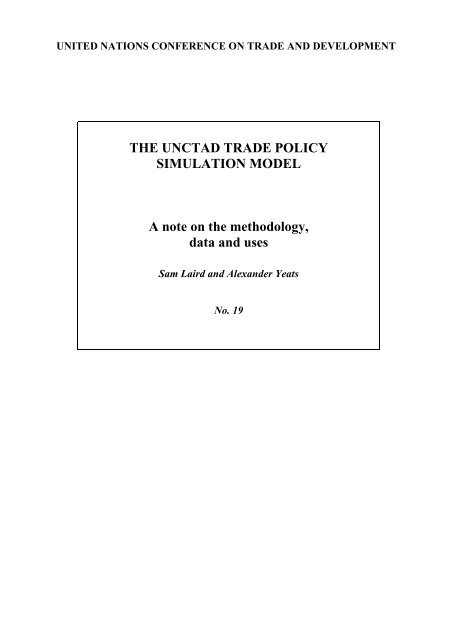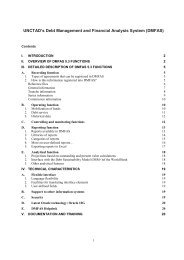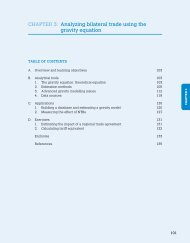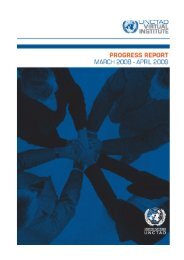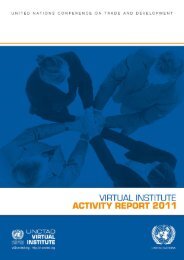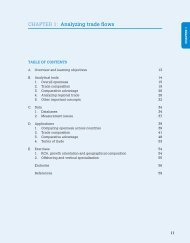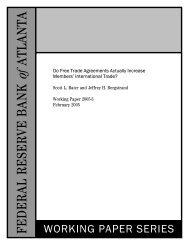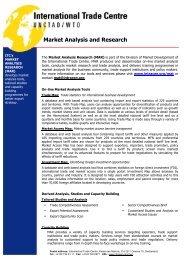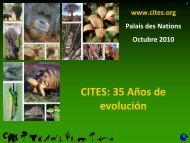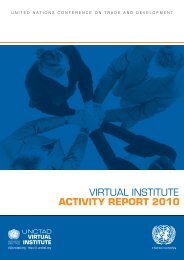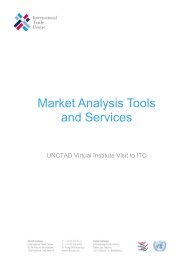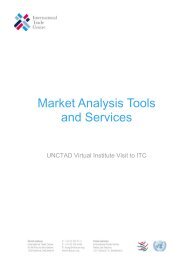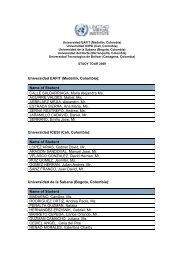THE UNCTAD TRADE POLICY SIMULATION MODEL A note on the ...
THE UNCTAD TRADE POLICY SIMULATION MODEL A note on the ...
THE UNCTAD TRADE POLICY SIMULATION MODEL A note on the ...
You also want an ePaper? Increase the reach of your titles
YUMPU automatically turns print PDFs into web optimized ePapers that Google loves.
The opini<strong>on</strong>s expressed in this paper do not necessarily reflect those of <strong>the</strong> <str<strong>on</strong>g>UNCTAD</str<strong>on</strong>g>secretariat. Comments <strong>on</strong> this paper are invited and should be addressed to <strong>the</strong> author, c/o <strong>the</strong>Chairman, <str<strong>on</strong>g>UNCTAD</str<strong>on</strong>g> Editorial Advisory Board, Palais des Nati<strong>on</strong>s, 1211 Geneva 10,Switzerland. Additi<strong>on</strong>al copies of this paper may be obtained <strong>on</strong> request.
<str<strong>on</strong>g>THE</str<strong>on</strong>g> <str<strong>on</strong>g>UNCTAD</str<strong>on</strong>g> <str<strong>on</strong>g>TRADE</str<strong>on</strong>g> <str<strong>on</strong>g>POLICY</str<strong>on</strong>g> <str<strong>on</strong>g>SIMULATION</str<strong>on</strong>g> <str<strong>on</strong>g>MODEL</str<strong>on</strong>g>A <str<strong>on</strong>g>note</str<strong>on</strong>g> <strong>on</strong> <strong>the</strong> methodology, data and usesSam Laird and Alexander YeatsGenevaOctober 1986GE.86-57273
CONTENTSSecti<strong>on</strong>PagePREFACEINTRODUCTION 1I. <str<strong>on</strong>g>THE</str<strong>on</strong>g> BASIC DATA AND PARAMETERS 4A. Tariffs 4B. N<strong>on</strong>-tariff barriers 5C. Imports 9D. Market penetrati<strong>on</strong> data 10E. Elasticities 11F. C<strong>on</strong>cordances 13II. USES OF <str<strong>on</strong>g>THE</str<strong>on</strong>g> <str<strong>on</strong>g>MODEL</str<strong>on</strong>g> 14III. FUTURE WORK ON <str<strong>on</strong>g>THE</str<strong>on</strong>g> <str<strong>on</strong>g>MODEL</str<strong>on</strong>g> 16IV. CO-OPERATION WITH O<str<strong>on</strong>g>THE</str<strong>on</strong>g>R ORGANIZATIONS 18ANNEX I:ANNEX II:TECHNICAL DESCRIPTION OF <str<strong>on</strong>g>THE</str<strong>on</strong>g> <str<strong>on</strong>g>UNCTAD</str<strong>on</strong>g> <str<strong>on</strong>g>TRADE</str<strong>on</strong>g><str<strong>on</strong>g>POLICY</str<strong>on</strong>g> <str<strong>on</strong>g>SIMULATION</str<strong>on</strong>g> <str<strong>on</strong>g>MODEL</str<strong>on</strong>g> 20PRIMARY SOURCES FOR ESTIMATES OF <str<strong>on</strong>g>THE</str<strong>on</strong>g> TARIFFEQUIVALENTS OF NON-TARIFF BARRIERS 26ANNEX III: ILUSTRATIONS OF <str<strong>on</strong>g>SIMULATION</str<strong>on</strong>g>S MADE WITH <str<strong>on</strong>g>THE</str<strong>on</strong>g><str<strong>on</strong>g>UNCTAD</str<strong>on</strong>g> <str<strong>on</strong>g>MODEL</str<strong>on</strong>g> 27Table A1:Table A2:Table A3:Table A4:Table A5:Grains to developing countries of trade liberalizati<strong>on</strong> throughreducti<strong>on</strong> to zero of tariffs in 20 DMECs, and (b) reducti<strong>on</strong> tozero of tariffs and certain n<strong>on</strong>-tariff barriers (NTBs) in EEC,Japan and <strong>the</strong> United States; 29Increases in imports by EEC from preference-receiving countriesthrough MFN liberalizati<strong>on</strong> of tariffs and n<strong>on</strong>-tariffs barriers; 30Actual values and projected changes in exports and trade balancesfor selected developing countries due to <strong>the</strong> adopti<strong>on</strong> of a GSTP; 31Projected changes in <strong>the</strong> structure of developing countries’intra-trade in primary and processed commodities underpreferential tariffs; 32Analysis of <strong>the</strong> influence of a debt-related trade liberalizati<strong>on</strong> <strong>on</strong> <strong>the</strong>export of all and selected developing countries. 33
<str<strong>on</strong>g>THE</str<strong>on</strong>g> <str<strong>on</strong>g>UNCTAD</str<strong>on</strong>g> <str<strong>on</strong>g>TRADE</str<strong>on</strong>g> <str<strong>on</strong>g>POLICY</str<strong>on</strong>g> <str<strong>on</strong>g>SIMULATION</str<strong>on</strong>g> <str<strong>on</strong>g>MODEL</str<strong>on</strong>g>A <str<strong>on</strong>g>note</str<strong>on</strong>g> <strong>on</strong> <strong>the</strong> methodology, data and usesSam Laird and Alexander Yeats 1PREFACEThis <str<strong>on</strong>g>note</str<strong>on</strong>g> has been prepared in resp<strong>on</strong>se to numerous requests from individual memberStates of <str<strong>on</strong>g>UNCTAD</str<strong>on</strong>g>, from o<strong>the</strong>r internati<strong>on</strong>al organizati<strong>on</strong>s and from academic instituti<strong>on</strong>s fordetailed informati<strong>on</strong> <strong>on</strong> <strong>the</strong> methodology and <strong>the</strong> data used in <strong>the</strong> <str<strong>on</strong>g>UNCTAD</str<strong>on</strong>g> Trade PolicySimulati<strong>on</strong> Model (TPSM).The model has been used principally in c<strong>on</strong>necti<strong>on</strong> with <str<strong>on</strong>g>UNCTAD</str<strong>on</strong>g>'s work <strong>on</strong>protecti<strong>on</strong>ism and structural adjustment as well as in evaluating various proposals for a GlobalSystem of Trade Preferences (GSTP) am<strong>on</strong>g developing countries. The results have beenpublished mainly in <strong>the</strong> Trade and Development Report, various documents for <str<strong>on</strong>g>UNCTAD</str<strong>on</strong>g>'s Tradeand Development Board and technical working <str<strong>on</strong>g>note</str<strong>on</strong>g>s <strong>on</strong> <strong>the</strong> GSTP. For technical reas<strong>on</strong>s, it wasnot possible to give a full descripti<strong>on</strong> of <strong>the</strong> model and data sources in such documents which areof a policy nature and restricted in size.The model has also been used to provide informati<strong>on</strong> <strong>on</strong> <strong>the</strong> direct trade effects of variouspossible trade liberalizati<strong>on</strong> scenarios to member States of <str<strong>on</strong>g>UNCTAD</str<strong>on</strong>g> and o<strong>the</strong>r internati<strong>on</strong>al organizati<strong>on</strong>s,notably UNIDO and <strong>the</strong> World Bank. In this c<strong>on</strong>necti<strong>on</strong>, it is felt that <strong>the</strong> modelwill be of major practical importance in helping developing countries to assess quantitatively <strong>the</strong>implicati<strong>on</strong>s of proposals for trade liberalizati<strong>on</strong> in any future multilateral trade negotiati<strong>on</strong>s(MTN), or to assist in evaluating <strong>the</strong> likely effects of changes in developed countries'generalized system of preference (GSP) schemes. In additi<strong>on</strong>, <strong>the</strong> <str<strong>on</strong>g>UNCTAD</str<strong>on</strong>g> secretariat hasemployed <strong>the</strong> model in quantifying <strong>the</strong> potential for alleviating developing country debtburdens through trade liberalizati<strong>on</strong> initiatives.The work <strong>on</strong> <strong>the</strong> model is <strong>on</strong>going, both with respect to <strong>the</strong> updating of <strong>the</strong> data and to <strong>the</strong>model itself. The present <str<strong>on</strong>g>note</str<strong>on</strong>g>, <strong>the</strong>refore, is representative <strong>on</strong>ly of <strong>the</strong> current situati<strong>on</strong> (April1986). Future readers are invited to c<strong>on</strong>sult <strong>the</strong> authors c<strong>on</strong>cerning revisi<strong>on</strong>s.Comments <strong>on</strong> data and methodology are welcomed, particularly suggesti<strong>on</strong>s forimprovement. The authors would also appreciate hearing from researchers who are c<strong>on</strong>ductingstudies into <strong>the</strong> restrictiveness of n<strong>on</strong>-tariff barriers.1 The authors are Ec<strong>on</strong>omic Affairs Officers, in <str<strong>on</strong>g>UNCTAD</str<strong>on</strong>g>, Geneva. The views expressed in this paper are those of <strong>the</strong>authors and do not necessarily reflect <strong>the</strong> views of <strong>the</strong> United Nati<strong>on</strong>s, or its staff.
1INTRODUCTION1. The model used by <str<strong>on</strong>g>UNCTAD</str<strong>on</strong>g> to estimate various effects of commercial policy changes, includingchanges in tariff rates and <strong>the</strong> incidence of n<strong>on</strong>-tariff distorti<strong>on</strong> of internati<strong>on</strong>al trade, may bedescribed technically as an ex ante partial equilibrium model, measuring <strong>the</strong> first-round effects of <strong>the</strong>simulated policy changes. (See Annex I for a full technical descripti<strong>on</strong>). The <str<strong>on</strong>g>UNCTAD</str<strong>on</strong>g> model is in<strong>the</strong> same class as that used by Cline et al. at The Brookings Instituti<strong>on</strong> to analyze <strong>the</strong> effects of <strong>the</strong>Tokyo Round, by <strong>the</strong> Internati<strong>on</strong>al M<strong>on</strong>etary Fund to quantify <strong>the</strong> effects of trade liberalizati<strong>on</strong>initiatives <strong>on</strong> developing country export earnings, and by Sapir and Baldwin to analyze <strong>the</strong> effects of<strong>the</strong> Tokyo Round <strong>on</strong> India. 22. The most important calculati<strong>on</strong>s in <strong>the</strong> simulati<strong>on</strong>s relate to <strong>the</strong> direct trade effects. Two distincteffects are calculated:(1) The trade creati<strong>on</strong> (or loss) effect resulting from <strong>the</strong> changed level of domestic demand forimports from a particular trading partner caused by <strong>the</strong> changed price of <strong>the</strong> imported goodafter <strong>the</strong> tariff change or relative to <strong>the</strong> price of <strong>the</strong> domestically produced substitute (it isassumed that <strong>the</strong> price change would fully reflect <strong>the</strong> tariff change, i.e. that <strong>the</strong> benefits of <strong>the</strong>tariff change would be passed <strong>on</strong> to c<strong>on</strong>sumers); and(2) The trade diversi<strong>on</strong> effect - <strong>the</strong> substituti<strong>on</strong> of goods coming from <strong>on</strong>e set of foreign suppliers forgoods from ano<strong>the</strong>r set of foreign suppliers. This results from <strong>the</strong> changes in <strong>the</strong> relative importprices (after payment of duties) of goods from <strong>the</strong> different sets of foreign suppliers as ac<strong>on</strong>sequence of changes in <strong>the</strong> differential in <strong>the</strong> rates which <strong>the</strong>y face. This can occur throughchanges in <strong>the</strong> MFN rate, <strong>the</strong> preference rate, if any, or both. If a preference rate for <strong>on</strong>e set ofcountries is introduced or reduced while <strong>the</strong> o<strong>the</strong>r set of countries c<strong>on</strong>tinues to face2 Gine, W.R., Trade Negotiati<strong>on</strong>s in <strong>the</strong> Tokyo Round - A Quantitative Assessment (The Brookings Instituti<strong>on</strong>,Washingt<strong>on</strong>, D.C., 1978); Internati<strong>on</strong>al M<strong>on</strong>etary Fund, Effects of Increased Market Access <strong>on</strong> Selected DevelopingCountry Export Earnings: An Illustrative Exercise. (DM/84/54), Washingt<strong>on</strong>. D.C., 24 August, 1984). Sapir, A. andBaldwin, R.E., "India and <strong>the</strong> Tokyo Round', World Development, Vol.II, No.7, 1983. For a n<strong>on</strong>-technical discussi<strong>on</strong> of<strong>the</strong> use of such models for evaluating <strong>the</strong> effects of various trade liberalizati<strong>on</strong> proposals, see Robert Stern, 'EvaluatingAlternative Formulae for Reducing Industrial Tariffs', Journal of World Trade Law,, 10 (Jan: Feb. 1976), pp.50-64.
<strong>the</strong> MFN rate, <strong>the</strong>n <strong>the</strong>re is positive trade diversi<strong>on</strong> in favour of <strong>the</strong> preference-receivingcountries and negative trade diversi<strong>on</strong> for <strong>the</strong> o<strong>the</strong>r set of countries.23. The trade creati<strong>on</strong> and trade diversi<strong>on</strong> effects are summed to provide <strong>the</strong> net effect in each marketfor each partner country, whe<strong>the</strong>r or not preference-receiving. An important assumpti<strong>on</strong> needs to bementi<strong>on</strong>ed: that any o<strong>the</strong>r limitati<strong>on</strong>s <strong>on</strong> <strong>the</strong> growth of imports (e.g. n<strong>on</strong>-tariff barriers or limits <strong>on</strong>GSP treatment) would be lifted to <strong>the</strong> extent necessary to permit <strong>the</strong> projected tariff-induced tradeexpansi<strong>on</strong> to take place. If <strong>the</strong>se limitati<strong>on</strong>s were maintained, <strong>the</strong>n <strong>the</strong> trade volume would not rise to<strong>the</strong> extent predicted, and quota rents, for example, would increase.4. The model can also be used directly to compute <strong>the</strong> price, revenue and welfare effects from tradeliberalizati<strong>on</strong>. Toge<strong>the</strong>r with data from UNIDO's Data Base <strong>on</strong> Industrial Statistics, it has also beenused to estimate <strong>the</strong> direct trade effects of liberalizati<strong>on</strong> <strong>on</strong> output and employment. There is scope forfur<strong>the</strong>r development in this respect.5. Partial equilibrium models are vulnerable to <strong>the</strong> criticism that <strong>the</strong>y do not take account of <strong>the</strong>ec<strong>on</strong>omy-wide effects of changes, although <strong>the</strong>y can be extended to approximate <strong>the</strong> results of interindustryeffects and <strong>the</strong> maintenance of equilibrium in <strong>the</strong> balance of trade. Theoretically, generalequilibrium models are more satisfactory, since <strong>the</strong>y also take account of sec<strong>on</strong>d-round effects, suchas inter-industry effects and exchange rate effects. 3 They, <strong>the</strong>refore, provide valuable insights into <strong>the</strong>inter-acti<strong>on</strong> of a large number of ec<strong>on</strong>omic variables. However, <strong>the</strong>y are also vulnerable to criticismsregarding <strong>the</strong> extensive underlying assumpti<strong>on</strong>s, and <strong>the</strong> results obtained using such models are verysensitive to changes in <strong>the</strong>se assumpti<strong>on</strong>s. There are a number of problems associated with workingversi<strong>on</strong>s of this modelling approach, not <strong>the</strong> least of which is <strong>the</strong> loss of detail which arises because itis necessary to work in large aggregates to make such models computable at reas<strong>on</strong>able cost.6. Although <strong>the</strong> partial equilibrium approach has a number of drawbacks, as a modelling approach ithas <strong>the</strong> advantage of working at a very fine level of detail. For example, in most studies3 One of <strong>the</strong> more comprehensive models of this type is <strong>the</strong> Michigan Model of World Producti<strong>on</strong> and Trade, a descripti<strong>on</strong>of which can be found in Deardorff, A.V., and Stern, R.M. The Michigan Model of World Producti<strong>on</strong> andTrade: Theory and Applicati<strong>on</strong>s, M.I.T. Press, Cambridge, Mass., 1986. For an example of <strong>the</strong> use of this model toexamine <strong>the</strong> impact of complete eliminati<strong>on</strong> of <strong>the</strong> post-Tokyo Round tariffs, see Deardorff, A.V. and Stern, R.M.. "Theec<strong>on</strong>omic effects of <strong>the</strong> complete eliminati<strong>on</strong> of post-Tokyo Round tariffs', in Trade Policy in <strong>the</strong> 1980s Cline,W.R.(ed.), Institute for Internati<strong>on</strong>al Ec<strong>on</strong>omics. Washingt<strong>on</strong> D.C. 1983.
3carried out at <str<strong>on</strong>g>UNCTAD</str<strong>on</strong>g>, tariff line informati<strong>on</strong> is used. This is extremely detailed, depending <strong>on</strong> <strong>the</strong>detail of <strong>the</strong> tariff classificati<strong>on</strong> and <strong>the</strong> number of trading partners. As an illustrati<strong>on</strong>, <strong>the</strong> United Statesdata for <strong>on</strong>e year c<strong>on</strong>tain in <strong>the</strong> order of 150,000 observati<strong>on</strong>s. Working at this level of detail permitsc<strong>on</strong>siderable precisi<strong>on</strong> in identifying key products and trading partners affected by particular tradepolicy scenarios. Methodologically, it has <strong>the</strong> advantage of avoiding <strong>the</strong> aggregati<strong>on</strong> bias that iscomm<strong>on</strong> to general equilibrium models.7. Since <strong>the</strong> <str<strong>on</strong>g>UNCTAD</str<strong>on</strong>g> model uses prior informati<strong>on</strong> <strong>on</strong> elasticities from o<strong>the</strong>r studies (i.e. it is asimulati<strong>on</strong> model not an estimating model), it is relatively easy to examine new policy opti<strong>on</strong>s <strong>on</strong> an exante basis.
4II. <str<strong>on</strong>g>THE</str<strong>on</strong>g> BASIC DATA AND PARAMETERSA. Tariffs8. The basic tariff data used in <strong>the</strong> model comes from <strong>on</strong>e of two sources. In <strong>the</strong> case of <strong>the</strong> majorityof <strong>the</strong> developed market-ec<strong>on</strong>omy countries (DMECs), tariff informati<strong>on</strong> is drawn from GATTcomputer tapes which are not available to all users. In <strong>the</strong> case of developing countries, tariffinformati<strong>on</strong> is coded in <str<strong>on</strong>g>UNCTAD</str<strong>on</strong>g>'s Trade Informati<strong>on</strong> System (TIS - a UNDP-supported project). DMEC tariff informati<strong>on</strong> has been used principally in studies <strong>on</strong> <strong>the</strong> effects of trade liberalizati<strong>on</strong>, mainlyfor <strong>the</strong> Trade and Development Board but also in <strong>the</strong> analysis of GSP schemes. Tariff informati<strong>on</strong> <strong>on</strong>developing countries has been used in <strong>the</strong> c<strong>on</strong>text of simulati<strong>on</strong>s of <strong>the</strong> effects of <strong>the</strong> GeneralizedSystem of Trade Preferences am<strong>on</strong>g developing countries.9. The GATT tapes c<strong>on</strong>tain a highly complex and extensive set of informati<strong>on</strong> <strong>on</strong> tariff rates. The main(but not <strong>the</strong> whole) set of informati<strong>on</strong> covers: <strong>the</strong> detailed nati<strong>on</strong>al tariff number (<strong>the</strong> number of digitsvaries from country to country, but in any case matches <strong>the</strong> detail of <strong>the</strong> corresp<strong>on</strong>ding GATT tradedata); <strong>the</strong> pre-MTN base rate tariffs (i.e. those in force in 1978); o<strong>the</strong>r tariff rates (such as applied rates,temporary rates and various preferential rates) when <strong>the</strong>y exist (i.e. GSP, EEC ACP preferences, etc.);<strong>the</strong> post-Tokyo Round MFN rate; and various codes covering <strong>the</strong> nature of <strong>the</strong> legal binding of <strong>the</strong>tariff, if any.10. In <strong>the</strong> <str<strong>on</strong>g>UNCTAD</str<strong>on</strong>g> model, <strong>the</strong> MFN tariff rates used as <strong>the</strong> base or initial rates for <strong>the</strong> simulati<strong>on</strong>s ofliberalizati<strong>on</strong> in <strong>the</strong> DMECs are <strong>the</strong> post-Tokyo Round statutory bound rates or, in <strong>the</strong> absence of abinding, <strong>the</strong> applied rates, but simulati<strong>on</strong>s have also been carried out using <strong>the</strong> applied rates for <strong>the</strong>most recent year for which data are available (mainly 1983). In cases where preferences exist (e.g.under <strong>the</strong> GSP or through o<strong>the</strong>r preferential arrangements such as EFTA or <strong>the</strong> Lome C<strong>on</strong>venti<strong>on</strong>) <strong>the</strong>appropriate preferential rate is used as <strong>the</strong> base rate. This base rate is that which is relevant to <strong>the</strong> yearfor which <strong>the</strong> trade data arc drawn. In <strong>the</strong> model, <strong>the</strong> base tariff
5rate is applied at <strong>the</strong> tariff-line level against individual partner countries (sometimes against groupsfacing comm<strong>on</strong> rates, e.g. preference-receiving countries under <strong>the</strong> GSP).11. In additi<strong>on</strong> to <strong>the</strong> basic tariff informati<strong>on</strong>, <str<strong>on</strong>g>UNCTAD</str<strong>on</strong>g> also takes account of ceilings or quotas in<strong>the</strong> operati<strong>on</strong> of <strong>the</strong> GSP. It would be desirable to include in <strong>the</strong> modelling exercises informati<strong>on</strong>about <strong>the</strong> extent to which imports from each trading partner enter at preferential rates or MFN ratesunder each tariff item. Unfortunately, this informati<strong>on</strong> is not available at <str<strong>on</strong>g>UNCTAD</str<strong>on</strong>g> for more than afew GSP d<strong>on</strong>or countries, mainly because importers regard this informati<strong>on</strong> as c<strong>on</strong>fidential. Suchdetailed informati<strong>on</strong> has been made available <strong>on</strong> computer tape by <strong>the</strong> United States, and wasloaded by <str<strong>on</strong>g>UNCTAD</str<strong>on</strong>g> from printed material from Australia. There have been problems inintroducing such informati<strong>on</strong> for o<strong>the</strong>r countries for which it is not c<strong>on</strong>fidential, and <strong>the</strong> data will beintroduced progressively. At present, for preference-granting countries o<strong>the</strong>r than <strong>the</strong> United Statesand Australia, <strong>the</strong> average utilizati<strong>on</strong> factor is used (taken from country reports provided under <strong>the</strong>GSP).12. In <strong>the</strong> case of developing country tariff rates, <strong>the</strong> TIS has c<strong>on</strong>centrated mainly <strong>on</strong> recording <strong>the</strong>MFN rate, and it has sometimes been necessary to c<strong>on</strong>vert specific rates to ad valorem terms. Forsome groups of developing countries, such as ASEAN, preferences that are allocated to o<strong>the</strong>rcountries in <strong>the</strong> particular group are also recorded. Fur<strong>the</strong>r informati<strong>on</strong> <strong>on</strong> developing countrypreference rates is being progressively added. Since tariff line trade data are not compiled for <strong>the</strong>secountries, it is necessary to compute <strong>the</strong> arithmetic mean of <strong>the</strong> tariff up to <strong>the</strong> level of <strong>the</strong> 4-digitSITC item. 4 At that level it is <strong>the</strong>n possible to use <strong>the</strong> United Nati<strong>on</strong>s Commodity Trade Statistics,Series D, to trade weight to a higher level of aggregati<strong>on</strong>.4 Arithmetic means of tariffs for sectors are typically higher than averages using current trade weights. This is because of <strong>the</strong>depressing effect of tariff restricti<strong>on</strong>s <strong>on</strong> imports. For a discussi<strong>on</strong> of aggregati<strong>on</strong> biases in <strong>the</strong> computati<strong>on</strong> of tariff averages seeLaird, S. and Yeats, A., 'Aggregati<strong>on</strong> biases in <strong>the</strong> computati<strong>on</strong> of tariff averages", Mimeo. <str<strong>on</strong>g>UNCTAD</str<strong>on</strong>g>, Geneva, 1986.
6B. N<strong>on</strong>-tariff barriers (NTBs)13. In order to use <strong>the</strong> model to estimate <strong>the</strong> trade liberalizati<strong>on</strong> effects of NTB eliminati<strong>on</strong>, a keyrequirement is comprehensive informati<strong>on</strong> <strong>on</strong> government-imposed trade restricti<strong>on</strong>s in <strong>the</strong> majorindustrialized country markets. Since no central records exist from which ad valorem equivalents of<strong>the</strong> NTBs could be drawn, this data deficiency has been resolved by c<strong>on</strong>ducting a major search of <strong>the</strong>professi<strong>on</strong>al literature in order to compile as many estimates as possible for <strong>the</strong> nominalequivalents of n<strong>on</strong>-tariff barriers. 5 However, in order to hold this aspect of <strong>the</strong> exercise to manageabledimensi<strong>on</strong>s, <strong>the</strong> search was specifically focused <strong>on</strong> a list of "core" products that had previouslybeen identified by <str<strong>on</strong>g>UNCTAD</str<strong>on</strong>g> as being of special export interest to <strong>the</strong> developing countries. 614. In <strong>the</strong> effort to compile informati<strong>on</strong> <strong>on</strong> nominal equivalents for NTBs, c<strong>on</strong>siderable use wasmade of a recent Internati<strong>on</strong>al M<strong>on</strong>etary Fund study which partially tabulated such statistics, aswell as a related survey c<strong>on</strong>ducted under <strong>the</strong> auspices of <strong>the</strong> Institute for Internati<strong>on</strong>al Ec<strong>on</strong>omicStudies, in Stockholm. 7 Table 1, which is drawn from <strong>the</strong> I M F study, indicates <strong>the</strong> types of studiesfrom which we have compiled data <strong>on</strong> <strong>the</strong> NTB ad valorem equivalent for use in our simulati<strong>on</strong>s.15. Although <strong>the</strong>se investigati<strong>on</strong>s generally c<strong>on</strong>centrated <strong>on</strong> manufactures, <strong>the</strong>y also c<strong>on</strong>tainedsome data <strong>on</strong> commodity protecti<strong>on</strong>. For most of <strong>the</strong> agricultural products in <strong>the</strong> core group, afairly extensive body of empirical informati<strong>on</strong> had been developed c<strong>on</strong>cerning <strong>the</strong> ad valoremincidence of existing n<strong>on</strong>-tariff barriers. Here, <strong>the</strong> starting point for <strong>the</strong> data collecti<strong>on</strong> effort was twogeneral analyses by <strong>the</strong> United Nati<strong>on</strong>s Food and Agricultural Organizati<strong>on</strong>, and <strong>the</strong> Internati<strong>on</strong>alFood Policy Research Institute (Washingt<strong>on</strong>), which examined <strong>the</strong> level and effects of agriculturalprotecti<strong>on</strong> in industrial countries. 8 Supplemental data was drawn from product-specific or countryspecificstudies which are fully listed in Annex II.5 The studies which have attempted to quantify <strong>the</strong> effects of <strong>the</strong>se measures relate primarily to <strong>the</strong> European Ec<strong>on</strong>omicCommunity, Japan and <strong>the</strong> United States. For this reas<strong>on</strong>, <strong>the</strong> simulati<strong>on</strong>s of <strong>the</strong> trade effects of liberalizing <strong>the</strong>se measures hadto be c<strong>on</strong>fined to <strong>the</strong>se three major markets.6 See <str<strong>on</strong>g>UNCTAD</str<strong>on</strong>g>, Problems of protecti<strong>on</strong>ism and structural adjustment (Part I), (TD B/IOJ9 (Part I)), Geneva, 28 January 1985.7 See, Internati<strong>on</strong>al M<strong>on</strong>etary Fund, Effects of Increased Market Access <strong>on</strong> Selected Developing Countries ExportEarnings: an Illustrative Exercise, (DM/84/54), Washingt<strong>on</strong>, D.C., 24 August 1984. The results of <strong>the</strong> Stockholm studyhave been published in Alexander Yeats, Trade Barriers Facing Development Countries: Commercial PolicyMeasures and Shipping L<strong>on</strong>d<strong>on</strong>, McMillan, 1979. A fur<strong>the</strong>r general source employed in <strong>the</strong> collecti<strong>on</strong> of data was Vern<strong>on</strong>R<strong>on</strong>ingen and Alexander Yeats, "N<strong>on</strong>-tariff Distorti<strong>on</strong> of Internati<strong>on</strong>al Trade: Some Preliminary Empirical Evidence",Weltitirtscnaftliches Arctuv, January 1977, pp. 613-624.8 See UN Food and Agricultural Organizati<strong>on</strong>, FAO Commodity Review and Outlook I979-1980. Rome, FAO,1979,
7Table IInformati<strong>on</strong> collated by IMF <strong>on</strong> tariff equivalents of tariff and n<strong>on</strong>tariffbarriers for seven commodities in four OECD markets(percentages)Sector United States EuropeanCommunitiesMeat49(a),16(b)6(c)118(a),50(b)104(d),37(c)Japan328(a),297(b)219(c)Canada52(a)Cereals20(e),55(c)0(b)81(h),35(e)73(b),51(d)34(c)175(b),70(e)139(c)Sugar 27(0, 18(c) 31(d),46(b)33(c)44(b),53(c)Textiles 59(e), 9(g) 50(e) 18(c) 39(j)Ir<strong>on</strong> and steel 6(g), 5(i) 6(o 3(i)Clothing 70(e), 9(g) 50(e) 23(e) 39(j)Footwear 2(g), 9(i) 12(i) 16(i) ...All sectors 33(e) 39(e) 62(e) ...Source: IMF, (op.cit.), Table 1.Notes: See following page. .16. With regard to <strong>the</strong> NTB equivalents compiled from <strong>the</strong>se sources, several specific points shouldbe <str<strong>on</strong>g>note</str<strong>on</strong>g>d. First, many of <strong>the</strong>se estimates were derived in a manner that <strong>the</strong>y reflect <strong>the</strong> "general" oraverage level of protecti<strong>on</strong> against all exporters and do not reflect any special differential adverseincidence which may exist <strong>on</strong> developing countries' exports. 9 Thus, in sectors like textiles andclothing, where goods originating in developing countries are subject to clear discriminati<strong>on</strong> under <strong>the</strong>Multifibre Arrangement, <strong>the</strong> estimated ad valorem equivalents of existing restricti<strong>on</strong>s aredownward biased. It is recognized that this problem produces a similar downwardpp.112-114, for basic data, and Alberto Valdes with <strong>the</strong> assistance of J. Hayssen, Trade Liberalizati<strong>on</strong> in AgriculturalCommodities and <strong>the</strong> Potential Foreign Exchange Benefits to Developing Countries, Washingt<strong>on</strong>, D.C.,Internati<strong>on</strong>al Food Policy Research Institute, 1979.9 The sources employed in tabulating <strong>the</strong> ad valorem equivalents of NTBs utilized various methods for arriving at <strong>the</strong>se estimates.It should be recognized that <strong>the</strong>re is no <strong>on</strong>e generally accepted procedure for quantifying n<strong>on</strong>-tariff measures and that all procedureswhich have been employed may be subject to various sources of bias. For a comprehensive analysis relating to this point, seeRobert Stern and Alan Deardorf, Methods of Measurement of N<strong>on</strong>-tariff barriers, <str<strong>on</strong>g>UNCTAD</str<strong>on</strong>g>/ST/MD/28, Geneva. 1985.
8I M F SOURCES OF INFORMATION ON NON-TARIFF BARRIERSReference <str<strong>on</strong>g>note</str<strong>on</strong>g>s for table 1(a) FAO, "Protecti<strong>on</strong>ism in <strong>the</strong> Livestock Sector", Rome, 1980. Estimates refer to beef for1977-79.(b) SJ.Anjaria, et al., "Developments in Internati<strong>on</strong>al Trade Policy", IMF Occasi<strong>on</strong>al PaperNo.16, Washingt<strong>on</strong>, D.C., 1982. Meat estimates refer to beef for 1977-79. Cereal estimatesrefer to a simple average for rice, maize and wheat for <strong>the</strong> United States; maize andwheat for <strong>the</strong> European Communities, and rice, wheat, barley and soybeans for Japan, in1979-80.(c) Japan Ec<strong>on</strong>omic Institute, "Agricultural Protecti<strong>on</strong>ism", Tokyo, 1983. Estimates for meatrefer to beef; for cereals, to grains for <strong>the</strong> United States and <strong>the</strong> European Communities,and to a simple average for rice, wheat and barley for Japan in 1978-80. Estimates forsugar also refer to 1978-80.(d) Comm<strong>on</strong>wealth Secretariat, Protecti<strong>on</strong>ism: Threat to Internati<strong>on</strong>al Order, L<strong>on</strong>d<strong>on</strong>, 1982.Estimates for meat refer to beef; and for cereals to a simple average for rice, maize and wheatin 1979-80. Estimates for sugar refer to <strong>the</strong> same time period.(e) A.J.Yeats, Trade Barriers Facing Developing Countries, New York, 1979. All estimates are for1973. For cereals, estimates refer to grains and grain products; for textiles, clothing andmanufactures, estimates are <strong>the</strong> sum of post-Kennedy Round tariffs and tariff equivalents forn<strong>on</strong>-tariff barriers. Tariff equivalents for n<strong>on</strong>-tariff barriers refer to apparel for both textilesand clothing.(f) Derived from U.S. Department of Agriculture, "Sugar and Sweetener: Outlook andSituati<strong>on</strong>", Washingt<strong>on</strong>, D.C., 1981. Estimates refer to 1979-80. Transport costs were assumedat 6 per cent of <strong>the</strong> c.i.f. price.(g) P. Morici and L. L. Megna, U.S. Ec<strong>on</strong>omic Policies Affecting Industrial Trade, Washingt<strong>on</strong>,D.C., 1983. The tariff equivalent for textiles reflects <strong>the</strong> impact of <strong>the</strong> MultifibreArrangement; for ir<strong>on</strong> and steel, it reflects <strong>the</strong> effects of several orderly market agreementswith Japan, and quotas against o<strong>the</strong>r producers; for footwear, it reflects orderly marketagreements with Taiwan and Korea between 1977-79.(h) U. Koester, "Policy Opti<strong>on</strong>s for <strong>the</strong> Grain Ec<strong>on</strong>omy of <strong>the</strong> European Community:Implicati<strong>on</strong>s for Developing Countries", IFPRI Research Report No.35, Washingt<strong>on</strong>, D.C.,1982. Estimates refer to a simple average for wheat, barley and maize for 1979-80.(i) Pre-Tokyo Round tariffs calculated in A.V. Deardorff and R.M.Stern, "The Effects of <strong>the</strong>Tokyo Round <strong>on</strong> <strong>the</strong> Structure of Protecti<strong>on</strong>". Paper presented at <strong>the</strong> C<strong>on</strong>ference <strong>on</strong> <strong>the</strong>Structure and Evoluti<strong>on</strong> of Recent U.S.Trade Policy, Nati<strong>on</strong>al Bureau of Ec<strong>on</strong>omicResearch, Cambridge, Mass., December 1982.(j) M. Wolf, "Managed Trade in Practice: Implicati<strong>on</strong>s of <strong>the</strong> Textile Arrangements", inW.R.Cline (ed.), Trade Policies in <strong>the</strong> 1980s, Washingt<strong>on</strong>, D.C., 1983. The simple averageof total protective rates for 16 products in 1979 was employed.bias in estimating <strong>the</strong> magnitude of <strong>the</strong> developing countries' trade expansi<strong>on</strong> associated with aremoval of <strong>the</strong>se restraints. 10 Ano<strong>the</strong>r (downward) bias occurs in respect of NTBs for which no10 In principle, this bias could occur in respect of any measure applying to a sub-group of trading partners, e.g. restricti<strong>on</strong>s <strong>on</strong>steel imports from o<strong>the</strong>r major developed market ec<strong>on</strong>omies.
9estimates of ad valorem equivalents could be found, e.g. "voluntary" export restraints. In suchcases, it is not possible, when using <strong>the</strong> model, to simulate <strong>the</strong> magnitude of trade expansi<strong>on</strong> associatedwith <strong>the</strong> barriers' removal. Finally, it should be <str<strong>on</strong>g>note</str<strong>on</strong>g>d that some ad valorem equivalents forn<strong>on</strong>-tariff barriers applied in <strong>the</strong> agricultural sector are quite volatile due to a wide year-to-yearvariati<strong>on</strong> in <strong>the</strong>se products' prices <strong>on</strong> internati<strong>on</strong>al markets. 11 In <strong>the</strong>se cases, it has often beennecessary to make a judgemental decisi<strong>on</strong> as to what c<strong>on</strong>stituted an average or "normal" level ofprotecti<strong>on</strong>, based <strong>on</strong> informati<strong>on</strong> relating to several years.C. Imports17. For <strong>the</strong> DMECs, <strong>the</strong> trade data used in <strong>the</strong> model are taken from <strong>the</strong> GATT trade tapes for <strong>the</strong>relevant year. This informati<strong>on</strong> is receded at <strong>the</strong> tariff-line level, thus permitting <strong>the</strong> matching oftariff and trade informati<strong>on</strong> <strong>on</strong> most DMECs. Import data in this series are recorded at <strong>the</strong> point ofclearing customs, even though <strong>the</strong>y may have been imported c<strong>on</strong>siderably earlier and held in b<strong>on</strong>d. In<strong>the</strong> case of <strong>the</strong> United States, Canada, Australia and New Zealand, imports arc valued <strong>on</strong> a free-<strong>on</strong>board(f.o.b) basis, while for all o<strong>the</strong>r developed countries a cost-insurance-freight (c.i.f) valuati<strong>on</strong>is employed. As a result, trade projecti<strong>on</strong>s made with <strong>the</strong> model vary between countries in terms off.o.b. and c.i.f. value.18. For developing countries <strong>the</strong> trade data are taken from <strong>the</strong> United Nati<strong>on</strong>s Commodity TradeStatistics, Series D, which uses <strong>the</strong> United Nati<strong>on</strong>s Standard Internati<strong>on</strong>al Trade Classificati<strong>on</strong>(SITC), both in Revisi<strong>on</strong> 1 and Revisi<strong>on</strong> 2, although predominantly in Revisi<strong>on</strong> 1 for developingcountries. Imports data in this series are recorded at <strong>the</strong> time of arrival in <strong>the</strong> importing country,even though some time may pass before <strong>the</strong>y clear customs. For <strong>the</strong> most part, <strong>the</strong>se data arerecorded at <strong>the</strong> four-digit level of <strong>the</strong> SITC. An additi<strong>on</strong>al point is that <strong>the</strong> developing country tradedata are normally several years out of date (<strong>on</strong> average <strong>the</strong>y now apply to <strong>the</strong> 1980-82 period)while more recent data (1984-85) are available for developed countries. This means that in11 As an example, ad valorem equivalents have been estimated by <strong>the</strong> <str<strong>on</strong>g>UNCTAD</str<strong>on</strong>g> secretariat for <strong>the</strong> European Ec<strong>on</strong>omicCommunity's variable import levies by taking <strong>the</strong> ratio of <strong>the</strong>se import charges to <strong>the</strong> internati<strong>on</strong>al prices of <strong>the</strong> products to which<strong>the</strong>y were applied. Due to variati<strong>on</strong>s in both prices and levies, this procedure generated estimated ad valorem equivalents for NTBsfacing some major agricultural imports that differed by as much as 100 percentage points from year to year. See <str<strong>on</strong>g>UNCTAD</str<strong>on</strong>g>,Protecti<strong>on</strong>ism and structural adjustment in agriculture (TD/B/939), Geneva, 17 March 1983, p.72, for time series <strong>on</strong> nominalequivalents for <strong>the</strong> EEC variable levies over <strong>the</strong> period 1975 to 1981.
10studies of <strong>the</strong> liberalizati<strong>on</strong> of trade am<strong>on</strong>g developing countries it was necessary to use data forearlier years for <strong>on</strong>e or two countries. In order to obtain c<strong>on</strong>sistent data sets, it would have beennecessary to use earlier data for all countries or to estimate trade data for later years for thosecountries for which <strong>the</strong> reported data were less recent.D. Market penetrati<strong>on</strong> data19. If <strong>the</strong> elasticity of substituti<strong>on</strong> between alternative suppliers is not known, it is still possible tocompute <strong>the</strong> trade diversi<strong>on</strong> effect using a formulati<strong>on</strong> developed by Baldwin and Murray. 12However, for this approach it is necessary to be able to calculate <strong>the</strong> level of import penetrati<strong>on</strong> byn<strong>on</strong>-preference-receiving countries, i.e. <strong>the</strong> share of imports from n<strong>on</strong>-preference-receivingcountries in apparent domestic c<strong>on</strong>sumpti<strong>on</strong> (defined as domestic output plus imports less exports).20. The principal source of informati<strong>on</strong> lies in <strong>the</strong> data which were first produced in <strong>the</strong> WorldBank Market Penetrati<strong>on</strong> Project. This work is now carried out at OECD under <strong>the</strong> title of "TheOECD Compatible Trade and Producti<strong>on</strong> Data Base 13 . Informati<strong>on</strong> is available <strong>on</strong> output, importsand exports for some 11 major DMEC markets under <strong>the</strong> Internati<strong>on</strong>al Standard IndustrialClassificati<strong>on</strong> (ISIC).12 Baldwin, R.E. and Murray, T. 'MFN Tariff reducti<strong>on</strong>s and developing country trade benefits under <strong>the</strong> GSP", TheEc<strong>on</strong>omic Journal. 87, March 1977. See <strong>the</strong> descripti<strong>on</strong> of <strong>the</strong> <str<strong>on</strong>g>UNCTAD</str<strong>on</strong>g> model in Annex I for <strong>the</strong> explanati<strong>on</strong> of this point.13For informati<strong>on</strong>, see Brodin, A., and Blades. D., "The OECD Compatible Trade and Producti<strong>on</strong> Data Base, 1970-1983',Department of Ec<strong>on</strong>omics and Statistics Working Papers, No.31, OECD, Paris, March, 1986.
11E. Elasticities( i ) Elasticity of import demand21. Informati<strong>on</strong> <strong>on</strong> elasticities of import demand came from a literature search. Primary use wasmade of a compendium prepared by Robert Stern with this informati<strong>on</strong> supplemented by additi<strong>on</strong>aldata taken from studies by <strong>the</strong> Brookings Instituti<strong>on</strong> and <strong>the</strong> Kiel Institute for World Ec<strong>on</strong>omics. 14 14 .(ii) Elasticity of export supply22. Informati<strong>on</strong> <strong>on</strong> elasticities of export supply has not yet been explicitly used in <strong>the</strong> model, sincecomprehensive informati<strong>on</strong> regarding <strong>the</strong> parameters is not readily available. The main simulati<strong>on</strong>snormally use an assumed value of infinity, and it is routine to carry out "sensitivity" tests based <strong>on</strong>simulati<strong>on</strong>s for different values, including assumpti<strong>on</strong>s of inelastic supply. Simulati<strong>on</strong>s withalternative values have shown that when supplies arc assumed to be relatively inelastic, <strong>the</strong> volumechanges are c<strong>on</strong>siderably less but <strong>the</strong>re is also a positive effect <strong>on</strong> <strong>the</strong> prices received by exporterswhich tends to compensate for this. The result is that with certain combinati<strong>on</strong>s of supply anddemand elasticities <strong>the</strong> revenue effect associated with reducti<strong>on</strong>s of tariffs or <strong>the</strong> eliminati<strong>on</strong> ofNTBs is often close to that under infinite supply elasticities.23. One important effect is not as yet taken into account for <strong>the</strong> cases where elasticities of supply aren<strong>on</strong>-infinite. This is <strong>the</strong> simultaneous impact of liberalizati<strong>on</strong> of trade in a number of markets, asmight happen following multilateral negotiati<strong>on</strong>s. Such liberalizati<strong>on</strong> toge<strong>the</strong>r with n<strong>on</strong>-infinitesupply elasticities is likely to cause a much smaller expansi<strong>on</strong> of trade volumes than are predicted by<strong>the</strong> present versi<strong>on</strong> of <strong>the</strong> model. However, <strong>the</strong> resulting price increases are also likely to behigher, thus operating as a counter to <strong>the</strong> smaller trade volumes in <strong>the</strong> computati<strong>on</strong> of <strong>the</strong> revenue14 See Robert Stern et al.. Price Elasticities in Internati<strong>on</strong>al Trade. L<strong>on</strong>d<strong>on</strong>, Macmillan, for <strong>the</strong> Trade Policy ResearchCentre, 1975; William Cline, et al. Trade Negotiati<strong>on</strong>s in <strong>the</strong> Tokyo Round: A Quantitative Assessment, Washingt<strong>on</strong>,D.C.. The Brookings Instituti<strong>on</strong>, 1978; and Rolf Langhammer, "Problems and Effects of a Developing Country's TariffC<strong>on</strong>cessi<strong>on</strong> Round <strong>on</strong> South-South Trade", Kiel Working Paper, No.167, Institute for World Ec<strong>on</strong>omics, Kiel, February1983.
12effect. This problem does not arise under <strong>the</strong> assumpti<strong>on</strong> of perfectly elastic supply since <strong>the</strong>re is noeffect <strong>on</strong> world prices.(iii) Elasticity of substituti<strong>on</strong>24. If explicit values are available for <strong>the</strong> elasticity of substituti<strong>on</strong> between goods from different sources<strong>the</strong>n it is not necessary to use an approach based <strong>on</strong> market penetrati<strong>on</strong> data (as menti<strong>on</strong>ed above).However, it is in any case an opti<strong>on</strong> to assume values for <strong>the</strong> elasticity of substituti<strong>on</strong> (and c<strong>on</strong>ductsimulati<strong>on</strong>s across a range of reas<strong>on</strong>able estimates). These elasticity values are used in <strong>the</strong> computati<strong>on</strong>of <strong>the</strong> trade diversi<strong>on</strong> effect, i.e. <strong>the</strong> extent to which trade is diverted from <strong>on</strong>e foreign supplier toano<strong>the</strong>r in c<strong>on</strong>sequence of shifts in relative prices resulting from differential movement in tariff rates or<strong>the</strong> ad valorem incidence of NTBs. 1525. It is implicit in computati<strong>on</strong>s of trade diversi<strong>on</strong>, as in this type of exercise, following Armingt<strong>on</strong> 16 ,that <strong>the</strong> products coming from different foreign sources (e.g. from developing countries or from o<strong>the</strong>rindustrialized countries) are imperfect substitutes. 17 It is <strong>the</strong>n possible to express <strong>the</strong> percentage changein <strong>the</strong> relative shares of <strong>the</strong> alternative suppliers in terms of <strong>the</strong> elasticity of substituti<strong>on</strong>, <strong>the</strong> percentagechange in relative prices and <strong>the</strong> original relative shares of imports from <strong>the</strong> alternative sources.C<strong>on</strong>stant market shares of individual countries within each group of foreign suppliers equally affectedby <strong>the</strong> trade policy change are assumed.F. C<strong>on</strong>cordances26. The various data series used in <strong>the</strong> model are classified under different systems (e.g. SITC,ISIC or nati<strong>on</strong>al tariff classificati<strong>on</strong>s - of which most but not all are based <strong>on</strong> <strong>the</strong> Customs Cooperati<strong>on</strong>Council Nomenclature (CCCN) at <strong>the</strong> 4-digit level). Since <strong>the</strong>se systems do not c<strong>on</strong>cord.15 For a discussi<strong>on</strong> of empirical estimates of <strong>the</strong> elasticity of substituti<strong>on</strong>, see Cline, (op.cit.). In The BrookingsInstituti<strong>on</strong> Model a value of 2.5 was used. It is probable that <strong>the</strong> elasticity is lower for highly differentiatedproducts, and vice versa. The higher <strong>the</strong> value of this elasticity, <strong>the</strong> higher <strong>the</strong> trade diversi<strong>on</strong> effects i.e. <strong>the</strong>benefits from <strong>the</strong> present arrangements would be higher than estimated, as would be <strong>the</strong> losses arising from <strong>the</strong>implementati<strong>on</strong> of <strong>the</strong> new arrangements.16 Armingt<strong>on</strong>, P., "A <strong>the</strong>ory of demand for products distinguished by place of producti<strong>on</strong>', IMF Staff Papers,Vol.16.1969, pp. 159-178.17 See also Learner, E. and Stern R.M., Quantitative Internati<strong>on</strong>al Ec<strong>on</strong>omic, Bost<strong>on</strong>, Alien and Bac<strong>on</strong> Inc.,1972, Chapter I I , <strong>on</strong> <strong>the</strong> c<strong>on</strong>cept of <strong>the</strong> elasticity of substituti<strong>on</strong> in internati<strong>on</strong>al trade.
13<strong>on</strong> a <strong>on</strong>e-to-<strong>on</strong>e basis <strong>the</strong>re are sometimes errors in cross-classifying data, particularly at <strong>the</strong> detailedlevel. The c<strong>on</strong>cordances of <strong>the</strong> nati<strong>on</strong>al tariff classificati<strong>on</strong>s of <strong>the</strong> United States(TSUSA) and of Canada - which are not CCCN-based - pose particular problems, not <strong>the</strong> leastbecause of reclassificati<strong>on</strong> of items from <strong>on</strong>e year to <strong>the</strong> next. Because of imperfecti<strong>on</strong>s in <strong>the</strong>c<strong>on</strong>cordances, especially for certain specific products, it can happen that, if <strong>on</strong>e wishes toexamine a particular industry as defined at, say, <strong>the</strong> 4-digit SITC level, <strong>the</strong> relevant tariffnumbers would include more or less products than those that are strictly within <strong>the</strong> SITC itemproduct descripti<strong>on</strong>. At higher levels of aggregati<strong>on</strong> <strong>the</strong>se problems are much less important.
14II. USES OF <str<strong>on</strong>g>THE</str<strong>on</strong>g> <str<strong>on</strong>g>MODEL</str<strong>on</strong>g>27. Two of <strong>the</strong> main uses of <strong>the</strong> model have been in c<strong>on</strong>necti<strong>on</strong> with <str<strong>on</strong>g>UNCTAD</str<strong>on</strong>g>'s work <strong>on</strong>protecti<strong>on</strong>ism and structural adjustment and also in providing technical backstopping to work <strong>on</strong> <strong>the</strong>GSTP. Examples of <strong>the</strong> output of <strong>the</strong> model for <strong>the</strong>se two different types of exercise are given inAnnex III, Tables Al to A5. Tables Al and A2 are taken from previously published <str<strong>on</strong>g>UNCTAD</str<strong>on</strong>g>documents and indicate <strong>the</strong> projected increase in developing country exports to <strong>the</strong> DMECs thatwould accompany a liberalizati<strong>on</strong> of selected tariffs and NTBs. Similar results could be easilygenerated for different product groups or for different liberalizati<strong>on</strong> proposals such as <strong>the</strong> generaltariff cutting formulae employed in <strong>the</strong> Tokyo Round multilateral trade negotiati<strong>on</strong>s. Table A3shows <strong>the</strong> results of <strong>on</strong>e particular policy opti<strong>on</strong> for <strong>the</strong> GSTP (i.e. implementati<strong>on</strong> of 20 percentlinear tariff preferences for intra-trade), while Annex Table A4 examines <strong>the</strong> likely impact of preferences<strong>on</strong> <strong>the</strong> level and structure of South-South commodity trade. Similar projecti<strong>on</strong>s could be madefor any o<strong>the</strong>r procedure for creating preferences for intra-developing country trade (even thoseinvolving differential exchange rates or transport cost preferences). The remaining Table A5 relatesto a study that was c<strong>on</strong>ducted by <str<strong>on</strong>g>UNCTAD</str<strong>on</strong>g> <strong>on</strong> trade-debt issues and shows how a trade liberalizati<strong>on</strong>in DMECs would influence <strong>the</strong> most heavily indebted countries and <strong>the</strong>ir major export products.28. Ano<strong>the</strong>r example of <strong>the</strong> use of <strong>the</strong> model is to identify in fine detail how specific products will beaffected by different trade policy approaches. This is something for which <strong>the</strong> model is particularlysuited, since <strong>the</strong> larger general equilibrium models do not work at this level of detail. An exampleof this use of <strong>the</strong> model is <strong>the</strong> identificati<strong>on</strong> of key products in particular markets where <strong>the</strong>developing countries would benefit from trade liberalizati<strong>on</strong>. Obviously, this type of applicati<strong>on</strong>could greatly assist developing countries in formulating trade liberalizati<strong>on</strong> proposals for any futuremultilateral negotiati<strong>on</strong>s.29. Ano<strong>the</strong>r example of <strong>the</strong> use of <strong>the</strong> model is to evaluate <strong>the</strong> direct trade effects of existingpreferences under <strong>the</strong> Generalised System of Preferences (GSP) for developing countries. Themodel can also be used to evaluate <strong>the</strong> effects of changes in <strong>the</strong> schemes and can even be used to
15simulate <strong>the</strong> likely effects of alternative opti<strong>on</strong>s which might be c<strong>on</strong>sidered. Related applicati<strong>on</strong>scould greatly assist developing countries in <strong>the</strong> design and implementati<strong>on</strong> of <strong>the</strong> GSTP.30. The model has also been used to provide informati<strong>on</strong> to developed and developing countries inevaluating trade policies, <strong>on</strong> request. Am<strong>on</strong>g <strong>the</strong> intended uses of this material has been <strong>the</strong>planning of new export ventures or <strong>the</strong> preparati<strong>on</strong> for balance-of-payment c<strong>on</strong>sultati<strong>on</strong>s withinGATT. The model has also been employed to assist developing countries in evaluating <strong>the</strong> potentialc<strong>on</strong>tributi<strong>on</strong> that trade liberalizati<strong>on</strong> initiatives could make towards alleviating <strong>the</strong>se nati<strong>on</strong>s'internati<strong>on</strong>al debt burdens.
16III. FUTURE WORK ON <str<strong>on</strong>g>THE</str<strong>on</strong>g> <str<strong>on</strong>g>MODEL</str<strong>on</strong>g>31. The following points cover <strong>the</strong> main areas for future refinement of <strong>the</strong> model as well as <strong>the</strong> data andparameters used.Elasticities:It is intended to c<strong>on</strong>duct fur<strong>the</strong>r research to extend <strong>the</strong> files <strong>on</strong> elasticities of importdemand, export supply and substituti<strong>on</strong> between different sources of supply fordifferent products and for different countries. As a l<strong>on</strong>g-term goal it may be desirableto make original estimates from ec<strong>on</strong>ometric analysis.NTBs:New work is needed to update and extend <strong>the</strong> files <strong>on</strong> <strong>the</strong> ad valorem equivalents ofn<strong>on</strong>-tariff barriers for different products in different countries, including countrieso<strong>the</strong>r than <strong>the</strong> EEC, Japan and <strong>the</strong> United States. This would primarily be <strong>on</strong> <strong>the</strong>basis of research into <strong>the</strong> ec<strong>on</strong>omic literature for estimates made by o<strong>the</strong>rorganizati<strong>on</strong>s and academic researchers. However, alternative approaches are beingexamined, including <strong>the</strong> possibility of estimates derived from <strong>the</strong> <str<strong>on</strong>g>UNCTAD</str<strong>on</strong>g> Data Base<strong>on</strong> Trade Measures. 18Employment:It is intended to extend <strong>the</strong> analysis of <strong>the</strong> ec<strong>on</strong>omic impact of trade liberalizati<strong>on</strong> too<strong>the</strong>r products and countries, including exporting countries. The analysis of indirectemployment effects can be expanded through <strong>the</strong> use of input-output tables for <strong>the</strong>importing, liberalizing countries and/or <strong>the</strong> exporting countries, so that <strong>the</strong> effects <strong>on</strong>related industries can be calculated. At present, <strong>the</strong> analysis of <strong>the</strong> employment effects islimited to <strong>the</strong> direct effects resulting from an expansi<strong>on</strong> of imports as a c<strong>on</strong>sequence of<strong>the</strong> importer's own liberalizati<strong>on</strong>, whereas <strong>the</strong> expansi<strong>on</strong> in exports results <strong>on</strong>ly from <strong>the</strong>liberalizati<strong>on</strong> by o<strong>the</strong>r countries.18 For informati<strong>on</strong> <strong>on</strong> <strong>the</strong> Data Base <strong>on</strong> Trade Measures, see "Introductory <str<strong>on</strong>g>note</str<strong>on</strong>g> <strong>on</strong> methodology employed and <strong>the</strong> problem ofdefiniti<strong>on</strong>s', prepared by <strong>the</strong> <str<strong>on</strong>g>UNCTAD</str<strong>on</strong>g> secretariat (TD/B/AC.42,2), 4 September 1985.
17O<strong>the</strong>r effects:It is possible to extend <strong>the</strong> model by equilibrating changes in imports and exports tosimulate exchange rate adjustments to restore balance of trade equilibrium, as has beend<strong>on</strong>e by Cline (op.cit.) However, this would still not simulate <strong>the</strong> restorati<strong>on</strong> of globalequilibrium, which is particularly important when a number of countries areundertaking simultaneous liberalizati<strong>on</strong> efforts as, for example, in <strong>the</strong> c<strong>on</strong>text ofmultilateral negotiati<strong>on</strong>s under <strong>the</strong> GATT or in <strong>the</strong> c<strong>on</strong>text of GSTP. To meet <strong>the</strong>seobjectives it is intended to expand <strong>the</strong> usefulness of <strong>the</strong> modeling work in co-operati<strong>on</strong>with o<strong>the</strong>r efforts in <str<strong>on</strong>g>UNCTAD</str<strong>on</strong>g>, in o<strong>the</strong>r internati<strong>on</strong>al organizati<strong>on</strong>s and in academicinstituti<strong>on</strong>s. This would permit <strong>the</strong> finely detailed informati<strong>on</strong> <strong>on</strong> tariffs and NTBsstored by <str<strong>on</strong>g>UNCTAD</str<strong>on</strong>g> to be used in compiling first-round effects of trade liberalizati<strong>on</strong>(reducing aggregati<strong>on</strong> bias comm<strong>on</strong> to larger models), while using <strong>the</strong> generalequilibrium models to analyse sec<strong>on</strong>d-round effects <strong>on</strong> a global basis.
18VI. Co-operati<strong>on</strong> with o<strong>the</strong>r organizati<strong>on</strong>s and governments32. <str<strong>on</strong>g>UNCTAD</str<strong>on</strong>g> has received a number of requests for simulati<strong>on</strong>s of specific policy changes al<strong>on</strong>g <strong>the</strong>lines of <strong>the</strong> present paper as well as simulati<strong>on</strong>s for changes in specific countries. For example, firstroundresults from <strong>the</strong> model for an MFN liberalizati<strong>on</strong> of tariffs and NTBs in <strong>the</strong> EEC, Japan and<strong>the</strong> United States have been used by <strong>the</strong> World Bank in a general equilibrium model to study a varietyof sec<strong>on</strong>d-round effects for <strong>the</strong> purposes of <strong>the</strong> World Development Report 1986.33. The model is also used to assist UNIDO c<strong>on</strong>sultants in <strong>the</strong> preparati<strong>on</strong> of sectoral studies <strong>on</strong> <strong>the</strong>effects of trade distorti<strong>on</strong>s which are used in UNIDO's system of c<strong>on</strong>sultati<strong>on</strong>s. For example, earlierversi<strong>on</strong>s of <strong>the</strong> model were used to assist UNIDO with respect to sectoral studies in <strong>the</strong> followingsectors: building materials; wood and wood products; oilseeds, vegetable oils and related products; andpetrochemicals. The current versi<strong>on</strong> of <strong>the</strong> model has been used to provide informati<strong>on</strong> for a UNIDOsectoral study <strong>on</strong> pharmaceuticals (not yet published). The UNIDO studies are as follows:• "Tariff and n<strong>on</strong>-tariff measures in <strong>the</strong> world trade of wood and wood products", SectoralStudies Branch, Divisi<strong>on</strong> for Industrial Studies, UNIDO (UNIDO/IS.396).• "Tariff and n<strong>on</strong>-tariff measures in <strong>the</strong> world trade of oilseeds wood, vegetable oils and relatedproducts", Sectoral Studies Branch, Divisi<strong>on</strong> for Industrial Studies, UNIDO (UNIDO/IS.396).• "Tariff and n<strong>on</strong>-tariff measures in <strong>the</strong> world trade of building materials", Sectoral StudiesBranch, Divisi<strong>on</strong> for Industrial Studies, UNIDO (UNIDO/IS.524).• "Tariff and n<strong>on</strong>-tariff measures in <strong>the</strong> world trade of petrochemicals", Sectoral Studies Branch,Divisi<strong>on</strong> for Industrial Studies, UNIDO (UNIDO/IS.573) - currently being revised for publicati<strong>on</strong>.
1934. Preliminary discussi<strong>on</strong>s have also been held with <strong>the</strong> representatives of <strong>the</strong> Internati<strong>on</strong>al DevelopmentResearch Centre (Canada) c<strong>on</strong>cerning <strong>the</strong> use of <strong>the</strong> model for assessing <strong>the</strong> likely impactof new customs uni<strong>on</strong>s am<strong>on</strong>g developing countries. Representatives of nati<strong>on</strong>al governments havebeen assisted by <strong>the</strong> secretariat <strong>on</strong> <strong>the</strong>ir request c<strong>on</strong>cerning use of <strong>the</strong> model in c<strong>on</strong>necti<strong>on</strong> withbalance-of-payment c<strong>on</strong>sultati<strong>on</strong>s in GATT and <strong>the</strong> IMF.
20ANNEXTechnical Descripti<strong>on</strong> of <strong>the</strong> <str<strong>on</strong>g>UNCTAD</str<strong>on</strong>g> Trade Policy Simulati<strong>on</strong> ModelThe basic model can be described in a series of equati<strong>on</strong>s and identities from which <strong>the</strong>formulati<strong>on</strong> for <strong>the</strong> simulati<strong>on</strong>s is derived. First <strong>the</strong> notati<strong>on</strong> is given:NOTATIONM - imports Mn - imports from n<strong>on</strong>-preference-receiving countriesX - exports V - output in <strong>the</strong> importing countryP - price R - revenueW - welfare t - tariff rate or n<strong>on</strong>-tariff distorti<strong>on</strong> inY - nati<strong>on</strong>al income ad valorem termsEm - elasticity of import demand with respect to domestic priceEx - elasticity of export supply with respect to export priceEs - elasticity of substituti<strong>on</strong> with respect to relative prices of <strong>the</strong>- same product from different sources of supplyTC - trade creati<strong>on</strong>TD - trade diversi<strong>on</strong>i - subscript denoting commodityj - subscript denoting domestic/importing country datak - subscript denoting foreign/exporting country data- (In certain expressi<strong>on</strong>s <strong>the</strong> subscript K is used to de<str<strong>on</strong>g>note</str<strong>on</strong>g> data for an- alternative foreign/exporting country)d - prefix denoting changeExamples:P ijk - Price of commodity i in country j from country k (i.e. domestic price in j)P ikj - Price of commodity i from country k to country j (i.e. export/world price j)M ijk - Imports of i by j from kX ikj - Exports of i by k to jThe basic modelThe importing country j’s import demand functi<strong>on</strong> for commodity i produced in country kmay be expressed as:(1) M ijk = F(Y j , P ij , P ik )The producer/exporting country k’s export supply functi<strong>on</strong> for commodity i may beexpressed as:
21(2) X ijk = F(P ikj )Expressi<strong>on</strong>s (1) and (2) are related by <strong>the</strong> following identity:(3) M ijk = X ikjAssuming that in a free trade situati<strong>on</strong> <strong>the</strong> domestic price of <strong>the</strong> commodity i in <strong>the</strong>importing market j will be equal to exporting country k’s export price plus transport andinsurance charges, it follows that this price will rise by an amount equivalent to <strong>the</strong> ad valoremincidence of any tariff or n<strong>on</strong>-tariff distorti<strong>on</strong> applied to <strong>the</strong> good. Thus:(4) P ijk = P ikj (l + t ijk )It is also clear that <strong>the</strong> export revenues earned by k are :(5) R ikj = X ikj .P ikjTrade creati<strong>on</strong>The trade creati<strong>on</strong> effect is <strong>the</strong> increased demand in country j for commodity i from exportingcountry k resulting from <strong>the</strong> price decrease associated with <strong>the</strong> assumed full transmissi<strong>on</strong> of pricechanges when tariff or n<strong>on</strong>-tariff distorti<strong>on</strong>s are reduced or eliminated.Given <strong>the</strong> basic model c<strong>on</strong>sisting of expressi<strong>on</strong>s (1) to (5), it is possible to write <strong>the</strong> basicformula for trade creati<strong>on</strong>s. First, from expressi<strong>on</strong> (4) it is possible to derive <strong>the</strong> total differential ofdomestic price with respect to tariffs and foreign price:(6) dP ijk = P ikj .dt ijk + (l + t ijk ).dP ikjNow, <strong>the</strong> standard expressi<strong>on</strong> for <strong>the</strong> elasticity of import demand with respect to <strong>the</strong> domesticprice can be rearranged as follows:(7) dM ijk /M ijk = Em.(dP ijk /P ijk )Substituting from expressi<strong>on</strong> (4) and (6) into expressi<strong>on</strong> (7) gives:(8) dM ijk /M ijk = Em.(dt ijk /(l + t ijk ) + dP ijk /P ikj )The standard expressi<strong>on</strong> for <strong>the</strong> elasticity of export supply with respect to <strong>the</strong> world price can berearranged as follows:(9) dP ikj /P ikj = (dX ikj /X ikj )/Ex
22From expressi<strong>on</strong> (3) it follows that:(10) dM ijk /M ijk = dX ikj /X ikjSubstituting expressi<strong>on</strong> (10) into (9) and <strong>the</strong> result into (8) produces <strong>the</strong> expressi<strong>on</strong> thatcan be employed to compute <strong>the</strong> trade creati<strong>on</strong> effect. From expressi<strong>on</strong> (3) this is equivalent toexporting country k’s growth of exports of commodity i to country j. The expressi<strong>on</strong> for tradecreati<strong>on</strong> can be written:(11) TC ijk = M ijk . Em.dt ijk /((l + t ijk ).(1.(Em/Ex))It may be <str<strong>on</strong>g>note</str<strong>on</strong>g>d that if <strong>the</strong> elasticity of export supply with respect to <strong>the</strong> world price isinfinite <strong>the</strong>n <strong>the</strong> denominator <strong>on</strong> <strong>the</strong> right hand side of expressi<strong>on</strong> (11) becomes unity and can beignored.Trade diversi<strong>on</strong>Following standard practice, <strong>the</strong> term trade diversi<strong>on</strong> is used to account for <strong>the</strong> tendency ofimporters to substitute goods from <strong>on</strong>e source to ano<strong>the</strong>r in resp<strong>on</strong>se to a change in <strong>the</strong> import priceof supplies from <strong>on</strong>e source but not from <strong>the</strong> alternative source. Thus, if prices fall in <strong>on</strong>e overseascountry <strong>the</strong>re will be a tendency to purchase more goods from that country and less from countrieswhose exports are unchanged in price. Trade diversi<strong>on</strong> can also occur not because of <strong>the</strong> change in<strong>the</strong> export price as such but because of introducti<strong>on</strong> or eliminati<strong>on</strong> of preferential treatment forgoods from <strong>on</strong>e (or more sources) while treatment for goods from o<strong>the</strong>r sources remains unchanged.Again <strong>the</strong>re could be simply a relative change in <strong>the</strong> treatment of <strong>the</strong> goods from different sourcesin <strong>the</strong> importing country by differential alterati<strong>on</strong>s in <strong>the</strong> treatment of different foreign suppliers.(i)Without explicit values for <strong>the</strong> elasticity of substituti<strong>on</strong>If <strong>the</strong> elasticity of substituti<strong>on</strong> between alternative suppliers is not known <strong>the</strong>n it is stillpossible to compute <strong>the</strong> trade diversi<strong>on</strong> effect using a formulati<strong>on</strong> developed by Baldwin andMurray. 19 However, for this approach it is necessary to be able to calculate <strong>the</strong> level of importpenetrati<strong>on</strong> by n<strong>on</strong>-preference-receiving countries, i.e. <strong>the</strong> level of imports from n<strong>on</strong>-preferencereceivingcountries in apparent domestic c<strong>on</strong>sumpti<strong>on</strong> (defined as domestic output of commodity iplus imports of commodity i less exports of commodity i). The formulati<strong>on</strong> for trade diversi<strong>on</strong> can<strong>the</strong>n be written:(13) TD ijk = TC ijk .(Mn ij /V ij )This formulati<strong>on</strong> assumes “<strong>the</strong> substitutability between a developing country product and asimilar product produced in n<strong>on</strong>-beneficiary i.e. n<strong>on</strong>-preference-receiving countries should besimilar to <strong>the</strong> substitutability between a developing country product and a similar product producedin <strong>the</strong> d<strong>on</strong>or importing country” (Id.).19 Baldwin, R.E. and Murray, T. “MFN tariff reducti<strong>on</strong>s and developing country trade benefits under <strong>the</strong> GSP”. TheEc<strong>on</strong>omic Journal 87, March 1977.
23(ii)With explicit values for <strong>the</strong> elasticity of substituti<strong>on</strong>If explicit values are available for <strong>the</strong> elasticity of substituti<strong>on</strong> between goods from differentsources <strong>the</strong>n it is not necessary to use <strong>the</strong> approach outlined above. Alternatively, if <strong>the</strong>re are nomarket penetrati<strong>on</strong> data available <strong>the</strong>n <strong>the</strong>re may be no opti<strong>on</strong> but to assume values for <strong>the</strong> elasticityof substituti<strong>on</strong> (and c<strong>on</strong>duct simulati<strong>on</strong>s across a range of reas<strong>on</strong>able estimates).It is possible to define <strong>the</strong> elasticity of substituti<strong>on</strong> as <strong>the</strong> percentage change in relativeshares associated with a <strong>on</strong>e percent change in <strong>the</strong> relative prices of <strong>the</strong> same product fromalternative sources. That is:d(ΣM ijk /ΣM ijK )/(ΣM ijk /ΣM ijK )(14) Es =___________________________d(P ijk /P ijK )/(P ijk /P ijK )where k de<str<strong>on</strong>g>note</str<strong>on</strong>g>s imports from <strong>on</strong>e (group) of foreign supplier(s),K de<str<strong>on</strong>g>note</str<strong>on</strong>g>s imports from ano<strong>the</strong>r (group) of foreign supplier(s),and <strong>the</strong> summati<strong>on</strong> is <strong>on</strong>ly across <strong>the</strong> country group k or K but notacross product groups (i) nor across imports (j).From this expressi<strong>on</strong> it is <strong>the</strong>n possible to express <strong>the</strong> percentage change in <strong>the</strong> relativeshares of <strong>the</strong> alternative suppliers in terms of <strong>the</strong> elasticity of substituti<strong>on</strong>, <strong>the</strong> percentage change inrelative prices and <strong>the</strong> original relative shares of imports from <strong>the</strong> alternative sources. By extensiveexpansi<strong>on</strong>, substituti<strong>on</strong> and rearrangement, it is possible to obtain <strong>the</strong> following expressi<strong>on</strong> for <strong>the</strong>change in imports from <strong>on</strong>e country – or trade diversi<strong>on</strong> (TD) gain or loss, as <strong>the</strong> case may be – as aresult of <strong>the</strong> change in duty paid prices relative to <strong>the</strong> prices from o<strong>the</strong>r sources resulting from acommercial policy change:d(P ijk /P ijK )ΣM ijk .ΣM ijK .Es._____________M ijkP ijk /P ijK(15) TD ijk=_____.______________________________ΣM ijk d(P ijk /P ijK )ΣM ijk + ΣM ijK + ΣM ijk .Es.____________P ijk /P ijKThe term in expressi<strong>on</strong> (15) for <strong>the</strong> relative price movement is specified in terms of <strong>the</strong>movements of <strong>the</strong> tariffs or <strong>the</strong> ad valorem incidence of n<strong>on</strong>-tariff distorti<strong>on</strong>s for <strong>the</strong> two foreignsources. Expressi<strong>on</strong> (15) is <strong>the</strong> equivalent of <strong>the</strong> final expressi<strong>on</strong> for trade diversi<strong>on</strong> given by Cline(op. cit.). As in Cline, similar expressi<strong>on</strong>s can be derived to obtain separate results for <strong>the</strong> differentgroups of foreign/exporting countries. Alternatively, <strong>the</strong> results can be summed for <strong>on</strong>e group, andthis sum can be distributed am<strong>on</strong>g members of <strong>the</strong> alternative group of foreign suppliers inaccordance with <strong>the</strong>ir prior share in <strong>the</strong> imports from that group.
24The total trade effectThe total trade effect is obtained simply by summing toge<strong>the</strong>r <strong>the</strong> trade creati<strong>on</strong> and tradediversi<strong>on</strong> effects. Results can be summed for <strong>the</strong> imported across product groups and/or acrosssources of supply. Results can be summed across groups of importers for single products or groupsof products as well as for single sources of supply or for groups of suppliers. Results can also besummed for suppliers across product groups. Finally, results can be summed for groups ofsuppliers ei<strong>the</strong>r for individual products or across product groups.The price effectIf <strong>the</strong> export supply elasticity is infinite <strong>the</strong>n <strong>the</strong>re is no price effect <strong>on</strong> exports. O<strong>the</strong>rwise<strong>the</strong> price effect can be obtained by substituting expressi<strong>on</strong> (10) into (9), giving:(16) dP ikj /P ikj = (dt ijk /(l + t ijk )).(Em/(Em-Ex))The revenue effectExpressi<strong>on</strong> (16) has direct applicati<strong>on</strong> in estimating <strong>the</strong> revenue effect for <strong>the</strong> exportingcountry. If <strong>the</strong> export supply elasticity is infinite, <strong>the</strong>re is no price effect – as <str<strong>on</strong>g>note</str<strong>on</strong>g>d above – andc<strong>on</strong>sequently revenue increases in proporti<strong>on</strong> to <strong>the</strong> increase in exports. O<strong>the</strong>rwise <strong>the</strong> percentageincrease in revenue is equal to <strong>the</strong> percentage increase in exports plus <strong>the</strong> percentage increase inprices. This can be shown by taking from expressi<strong>on</strong> (5) above <strong>the</strong> total differential of revenue withrespect to export price and <strong>the</strong> volume of exports:(17) dR ikj = P ikj .dX ikj + X ikj .dP ikjDividing <strong>the</strong> left-hand side (LHS) of (17) with <strong>the</strong> LHS of expressi<strong>on</strong> (5) and <strong>the</strong> right-handside (RHS) of (17) with <strong>the</strong> RHS of (5) gives:(18) dR ikj /R ikj = (P ikj .dX ikj + X ikj .dP ikj )/(P ikj .X ikj )Reducing and substituting from expressi<strong>on</strong> (10) gives:(19) dR ikj /R ikj = (dM ikj /M ijk ) + (dP ikj /P ikj )Alternatively, this can be written:(20) dR ikj /R ikj = (dt ijk /(l + t ijk )).Em.((1 + Ex)/(Ex-Em))The welfare effectThe welfare effect arises from <strong>the</strong> benefits c<strong>on</strong>sumers in <strong>the</strong> importing country derive from<strong>the</strong> lower domestic prices after <strong>the</strong> removal or reducti<strong>on</strong> of tariffs or <strong>the</strong> ad valorem incidence ofn<strong>on</strong>-tariff distorti<strong>on</strong>s. As <str<strong>on</strong>g>note</str<strong>on</strong>g>d by Cline (op.cit.), “for <strong>the</strong> pre-existing level of imports, any pricereducti<strong>on</strong> to <strong>the</strong> c<strong>on</strong>sumer merely represents a transfer away from <strong>the</strong> government of tariff revenueformerly collected <strong>on</strong> <strong>the</strong> import and <strong>the</strong>refore no net gain to <strong>the</strong> country as a whole. But for <strong>the</strong>increase in imports, <strong>the</strong>re is a net welfare gain equal to <strong>the</strong> domestic c<strong>on</strong>sumers’ valuati<strong>on</strong> of <strong>the</strong>extra imports minus <strong>the</strong> cost of extra imports at supply price (excluding tariffs)”. Thus, <strong>the</strong> netwelfare gain is normally estimated as <strong>the</strong> increase in import value times <strong>the</strong> average between <strong>the</strong> ad
25valorem incidence of <strong>the</strong> trade barriers before and after <strong>the</strong>ir eliminati<strong>on</strong>. This welfare gain canalso be thought of as <strong>the</strong> increase in c<strong>on</strong>sumer surplus. It can be written:(21) W ijk = 0.5(dt ijk. dM ijk )In <strong>the</strong> case where <strong>the</strong> elasticity of export supply is less than infinity <strong>the</strong> supply price ishigher than previously. The new domestic price of imports does not decline to <strong>the</strong> full extent of <strong>the</strong>tariff change and import expansi<strong>on</strong> is less than in <strong>the</strong> case of infinitely elastic export supply.Welfare can still be computed using expressi<strong>on</strong> (21) but needs to be interpreted as a combinati<strong>on</strong> ofc<strong>on</strong>sumer surplus and producer surplus.
26ANNEX IIPrimary Sources for Estimates of <strong>the</strong> Tariff Equivalents of NTBsWilliam Cline, et.al., Trade Negotiati<strong>on</strong>s in <strong>the</strong> Tokyo Round: A QuantitativeAssessment,Washingt<strong>on</strong>, D.C., Brookings Instituti<strong>on</strong>, 1978.Comm<strong>on</strong>wealth Secretariat, Protecti<strong>on</strong>ism - Threat to Internati<strong>on</strong>al Order: The Impact <strong>on</strong>Developing Countries, L<strong>on</strong>d<strong>on</strong>, 1982.Carl Hamilt<strong>on</strong>, "Voluntary Export Restraints <strong>on</strong> Asia: Tariff Equivalents, Rents and Trade BarrierInformati<strong>on</strong>", Seminar Paper No.276, Stockholm, Institute for Internati<strong>on</strong>al Ec<strong>on</strong>omic Studies,April, 1984.Internati<strong>on</strong>al M<strong>on</strong>etary Fund, Effects of Increased Market Access <strong>on</strong> Selected DevelopingCountries' Export Earnings: An Illustrative Exercise, (DM/84/54), Washingt<strong>on</strong>.D.C, 24August 1984.P. Morici and L. Megna, US Ec<strong>on</strong>omic Policies Affecting Industrial Trade, Washingt<strong>on</strong>, D.C., Nati<strong>on</strong>alPlanning Associati<strong>on</strong>, 1983.V. R<strong>on</strong>ingen and A. Yeats, "N<strong>on</strong>-tariff Distorti<strong>on</strong>s of Internati<strong>on</strong>al Trade: Some Preliminary EmpiricalEvidence", Weltwirtschaftliches Archiv, Band 112, Heft 3, 1976, pp.613-623.G. Samps<strong>on</strong> and A. Yeats, "An Evaluati<strong>on</strong> of <strong>the</strong> Comm<strong>on</strong> Agricultural Policy as a Barrier FacingAgricultural Exports to <strong>the</strong> European Ec<strong>on</strong>omic Community", American Journal of AgriculturalEc<strong>on</strong>omics, No.59, February 1977, pp.99-106.E. Sax<strong>on</strong> and Kym Anders<strong>on</strong>, Japanese Agricultural Protecti<strong>on</strong> in Historical Perspective,Canberra, Research School of Pacific Studies - Australian Nati<strong>on</strong>al University, July 1982.United Nati<strong>on</strong>s Food and Agricultural Organizati<strong>on</strong>, "New Protecti<strong>on</strong>ism and Attempts at Liberalizati<strong>on</strong>in Agricultural Trade", Chapter III, in Commodity Review and Outlook: 1979-80, Rome,1980, pp. 109-121.United Nati<strong>on</strong>s Food and Agricultural Organizati<strong>on</strong>, Protecti<strong>on</strong>ism in <strong>the</strong> Oilseeds, Oils andOilmeals Sector, (CCP: of 81/2) Rome, January, 1981.United Nati<strong>on</strong>s Food and Agricultural Organizati<strong>on</strong>, Agricultural Protecti<strong>on</strong>ism andStabilizati<strong>on</strong> Policies: A Framework of Measurement in <strong>the</strong> C<strong>on</strong>text of AgriculturalAdjustment,(C.75/LIM/2)Rome, October 1975.United Nati<strong>on</strong>s Food and Agricultural Organizati<strong>on</strong>, Protecti<strong>on</strong>ism in <strong>the</strong> Livestock Sector, (CCP80/4), Rome, October 1980.<str<strong>on</strong>g>UNCTAD</str<strong>on</strong>g>, Protecti<strong>on</strong>ism and structural adjustment in Agriculture, (TD/B/939), Geneva, 17March 1983.United States Federal Trade Commissi<strong>on</strong>, Effects of Restricti<strong>on</strong>s <strong>on</strong> United States Imports: FiveCase Studies and <strong>the</strong>ory. Staff Report of <strong>the</strong> Bureau of Ec<strong>on</strong>omics to <strong>the</strong> Federal Trade Commissi<strong>on</strong>,Washingt<strong>on</strong>, D.C., June 1980.
27ANNEX IIIILLUSTRATIONS OF <str<strong>on</strong>g>SIMULATION</str<strong>on</strong>g>S MADE WITH <str<strong>on</strong>g>THE</str<strong>on</strong>g> <str<strong>on</strong>g>UNCTAD</str<strong>on</strong>g><str<strong>on</strong>g>MODEL</str<strong>on</strong>g>Explanatory <str<strong>on</strong>g>note</str<strong>on</strong>g>Table Al illustrates <strong>the</strong> results of a simulati<strong>on</strong> covering <strong>the</strong> effects <strong>on</strong> developing countriesof <strong>the</strong> eliminati<strong>on</strong> of both tariff and n<strong>on</strong>-tariff barriers. Tariff eliminati<strong>on</strong> was simulated for 20DMECs for which tariff informati<strong>on</strong> is held, while tariff and NTB eliminati<strong>on</strong> is simulated for <strong>the</strong>EEC, Japan and <strong>the</strong> United States. The separate effects of preferential and MFN liberalizati<strong>on</strong> weresimulated. The results are shown for all 3-digit ISIC industries. The simulati<strong>on</strong>s were based <strong>on</strong>1983 import data from <strong>the</strong> GATT trade tapes and assume infinite supply capabilities. Thesesimulati<strong>on</strong>s used <strong>the</strong> versi<strong>on</strong> of <strong>the</strong> model with an explicit elasticity of substituti<strong>on</strong> am<strong>on</strong>g foreignsuppliers, which was assumed to equal 2 in all industries. These results were reported in "Problems ofprotecti<strong>on</strong>ism and structural adjustment -Introducti<strong>on</strong> and Part I: Restricti<strong>on</strong>s <strong>on</strong> trade and structuraladjustment", report by <strong>the</strong> <str<strong>on</strong>g>UNCTAD</str<strong>on</strong>g> secretariat (TD/B/10Sl(Part I), Chapter III).Table A2 presents more detailed results from <strong>the</strong> same simulati<strong>on</strong>s that were carried out forTable Al. The informati<strong>on</strong> for <strong>the</strong> effects <strong>on</strong> developing countries of MFN liberalizati<strong>on</strong> of tariffsand NTBs by <strong>the</strong> EEC at <strong>the</strong> 4-digit CCCN level was ranked in order of magnitude of <strong>the</strong> value of<strong>the</strong> gains in S US. The table lists <strong>the</strong> top fifty items in order of <strong>the</strong> size of projected trade gains.Accordingly, this table represents <strong>the</strong> list of items <strong>on</strong> which developing countries would gain mostfrom liberalizati<strong>on</strong> by <strong>the</strong> EEC and which would <strong>the</strong>refore be expected to rank highest in any"request list" for negotiati<strong>on</strong>s. Similar lists were computed for Japan and <strong>the</strong> United States, and areshown in "Problems of protecti<strong>on</strong>ism and structural adjustment - Introducti<strong>on</strong> and Part I : restricti<strong>on</strong>s<strong>on</strong> trade and structural adjustment", report by <strong>the</strong> <str<strong>on</strong>g>UNCTAD</str<strong>on</strong>g> secretariat (TD/B/I081(Part I), AnnexII).Annex Table A3 shows <strong>the</strong> results from a simulati<strong>on</strong> of <strong>the</strong> influence of preferences for intratrade<strong>on</strong> <strong>the</strong> exports, imports and trade balances of selected major developing countries or countrygroups. The simulati<strong>on</strong> assumed that preferences were generated through 10, 20 and 50 per centlinear tariff cuts and that supply in developing countries was infinitely elastic. For more details,including <strong>the</strong> projected effects of different preferential tariff margins, see <str<strong>on</strong>g>UNCTAD</str<strong>on</strong>g>, C<strong>on</strong>siderati<strong>on</strong>srelating to <strong>the</strong> negotiating elements and likely ec<strong>on</strong>omic effects of a global system of trade preferences(GSTP) am<strong>on</strong>g developing countries, (<str<strong>on</strong>g>UNCTAD</str<strong>on</strong>g>/ECDC/179) (Geneva: 9 July 1985).Annex Table A4 summarizes <strong>the</strong> results of simulati<strong>on</strong>s of <strong>the</strong> effects of full tariff preferences (TOOper cent preferential margins) <strong>on</strong> <strong>the</strong> commodity intra-trade of developing countries. The table shows <strong>the</strong>projected change in <strong>the</strong> value of this exchange under three different assumpti<strong>on</strong>s c<strong>on</strong>cerning supplyc<strong>on</strong>diti<strong>on</strong>s (perfectly elastic supply, unitary' elastic supply and a case when export prices rise by <strong>on</strong>ethirdof <strong>the</strong> corresp<strong>on</strong>ding change in volumes) and also indicates <strong>the</strong> resulting changes in developingcountries' trade shares. See Samuel Laird and Alexander Yeats, 'Empirical Evidence C<strong>on</strong>cerning <strong>the</strong>Magnitude and Effects of Developing Country Tariff Escalati<strong>on</strong>", mimeo. <str<strong>on</strong>g>UNCTAD</str<strong>on</strong>g> Geneva, 1-4 April1986.Annex A5 is drawn from a simulati<strong>on</strong> study that examined <strong>the</strong> use of trade liberalizati<strong>on</strong>initiatives for alleviating <strong>the</strong> debt burdens of <strong>the</strong> most heavily indebted developing
28countries. The table shows <strong>the</strong> projected expansi<strong>on</strong> of <strong>the</strong>se nati<strong>on</strong>s' exports resulting from a fullpreferential liberalizati<strong>on</strong> of tariffs and NTBs applied to <strong>the</strong>ir "core" products in <strong>the</strong> EEC, Japan and<strong>the</strong> United States. In <strong>the</strong>se projecti<strong>on</strong>s supply is assumed to be perfectly elastic, but sensitivity testsarc run <strong>on</strong> this parameter in <strong>the</strong> full study. For details, see Samuel Laird and Alexander Yeats, "On<strong>the</strong> Potential C<strong>on</strong>tributi<strong>on</strong> of Trade Policy Initiatives for Alleviating <strong>the</strong> Internati<strong>on</strong>al Debt Crisis",mimeo. <str<strong>on</strong>g>UNCTAD</str<strong>on</strong>g>, Geneva, 2 November 1985.
29TABLE I: Gains to developing countries of trade liberalizati<strong>on</strong> through (a) reducti<strong>on</strong> to zero of tariffs in 20 developed market ec<strong>on</strong>omy countries, and (b) reducti<strong>on</strong> to zero of tariffs andcertain n<strong>on</strong>-tariff barriers (NTBs) in <strong>the</strong> EEC, Japan and United States ($ milli<strong>on</strong>)20 DMECs EEC, Japan and United States <strong>on</strong>lyISIC IndustryTariff lib. gains Incl. imports under liberalizati<strong>on</strong>Imports1983 (a) MFN (b) Pref.Imports1983(a) MFN (b) Pref.TariffsTariffs + NTBs Tariffs111 Agric. + livestock 12609 251 480 11291 230 329 432 592113 Hunting, trapping, etc. 12 0 0 2 0 0 0 0121 Forestry 1940 0 0 1833 0 0 0 0122 Logging 2109 0 0 2099 0 0 0 0130 Fishing 3107 165 228 2982 164 1013 226 1465210 Coal mining 49 1 2 14 1 1 2 2220 Crude petroleum 100817 1157 1675 94894 1542 1542 1639 1639230 Mining 6195 0 0 5356 0 0 0 0290 St<strong>on</strong>e quarrying, etc. 3468 33 44 2956 32 32 42 42311 Food products 20236 900 1272 18538 835 4087 1177 5122312 Food products nes 399 16 26 266 16 40 24 58313 Beverages 544 47 304 478 44 48 286 298314 Tobacco 293 32 38 285 30 30 35 35321 Textiles 7921 1190 2007 6502 826 3194 1191 5162322 Wearing apparel 9779 4728 5076 9146 4506 11785 4688 12461323 Lea<strong>the</strong>r & products 1322 228 304 1123 167 261 208 303324 Footwear 219 30 35 206 25 123 29 137331 Wood products 2521 116 201 2296 102 102 166 166341 Paper & products 701 10 42 589 7 12 34 43342 Printing, publishing 319 2 12 261 2 3 10 13351 Industrial chemicals 3401 82 274 2928 67 79 235 251352 O<strong>the</strong>r chemical prods. 1350 11 51 1102 13 33 47 161353 Petroleum refineries 21440 648 1078 17741 645 645 1071 1071354 Petroleum, coal prods. 30770 157 158 31069 156 156 157 157355 Rubber products 2267 1359 1495 1977 1209 2207 1234 2234356 Plastic products, nec 542 148 229 440 85 85 143 183361 Pottery, china, etc. 169 74 105 149 70 70 92 92362 Glass + products 218 10 36 191 9 16 29 51369 N<strong>on</strong>-metal prods. nec 327 11 36 333 9 9 28 30371 Ir<strong>on</strong> + steel 2905 181 247 2440 168 702 212 1043372 N<strong>on</strong>-ferrous metals 7361 45 190 7850 46 229 187 436380 Fab. metal products 946 0 0 157 0 8 0 8381 Metal products 1486 154 355 1264 79 296 199 529382 Machinery nec 2939 205 434 2978 196 200 394 407383 Electrical machinery 8462 871 1514 8017 781 1337 1305 2076384 Transport equipment 2727 177 382 2003 146 274 283 450385 Professi<strong>on</strong>al goods 3086 194 425 2492 100 100 272 272390 O<strong>the</strong>r industries 2946 398 545 2566 364 438 468 563410 Energy 4 0 0 2 0 0 0 0610 Wholesale trade 6 0 0 6 0 0 0 0620 Retail trade 176 0 0 156 0 0 0 0832 Var. business services 21 0 2 19 0 0 1 1941 Movies, etc. 10 0 1 9 0 0 0 0959 Photographic studios 89 0 2 84 0 0 1 11-9 ALL <str<strong>on</strong>g>TRADE</str<strong>on</strong>g> 268204 14043 19303 247091 12671 29485 16549 37557Source: Table 8 of <str<strong>on</strong>g>UNCTAD</str<strong>on</strong>g> document TD/B/1081 (Part I) of 23 January, 1985Note: The 20 DMECs are Australia, Austria, Canada, EEC (10 countries), Finland, Japan, New Zealand, Norway, Sweden, Switzerland and <strong>the</strong> United States.Tariffs+ NTBs
18.4.8630Table A4Projected Changes in <strong>the</strong> Structure of Developing Countries’ Intra-Trade in Primary and Processed CommoditiesUnder Preferential Tariffs1981 Value ofintra-trade ($ milli<strong>on</strong>)Primarystage______Processedproducts_______Share ofprocessedproducts________ValueProjected change in developing country intra-tradeIn processed commodities under tariff preferences a/($ milli<strong>on</strong>) Processed products’ shareProcessing chaine s = ∞ e s = 3.0 e s = 1.0 e s = ∞ e s = 3.0 e s = 1.0_______ _______ ______ _____ ______ __________All Commodities 51,644.8 13,874.9 21.2 2,529.5 1,894.4 1,365.0 2.4 1.8 1.3All commodities (excl. petroleum) 6,871.0 6,182.7 47.4 1,491.4 1,132.1 845.7 3.9 3.0 2.1of which:Meat 547.7 49.8 8.0 12.6 9.8 8.1 1.8 1.5 1.2Fish 260.4 125.6 32.5 36.0 29.4 23.6 4.1 3.1 2.4Fruit 857.9 157.3 15.5 23.9 19.2 15.2 1.1 0.8 0.5Vegetables 555.6 73.7 11.7 9.8 9.6 9.3 0.6 0.6 0.6Vegetables oils b/ 70.0 147.5 67.8 9.3 6.9 4.8 0.1 -0.1 -0.3Coffee, cocoa and sugar 1,798.9 121.5 6.3 38.2 30.9 24.5 1.4 1.1 0.9Lea<strong>the</strong>r 54.8 123.7 69.2 43.8 30.2 22.1 8.1 4.3 3.3Rubber 1,295.3 262.3 16.9 151.8 91.0 63.4 7.1 4.3 3.0Wood and paper 69.6 2,107.0 96.8 258.7 217.3 157.9 -0.5 -0.5 -0.5Wool 25.5 26.7 51.1 25.9 21.1 17.1 12.7 10.6 8.7Cott<strong>on</strong> 486.7 348.2 41.7 258.9 186.8 132.4 13.0 9.9 7.3Ir<strong>on</strong> 314.4 1,235.2 79.7 300.1 233.9 186.2 3.1 2.4 2.0Copper 183.2 697.7 79.2 157.3 115.2 79.4 2.8 2.0 1.3Bauxite 35.4 306.0 89.6 87.9 71.6 57.6 2.1 1.8 1.5Lead 11.0 51.2 82.3 6.8 5.2 3.9 1.5 1.1 0.8Zinc 26.4 85.7 76.4 15.2 12.2 9.8 2.4 1.9 1.6Tin 56.9 128.5 69.3 28.7 20.5 13.6 4.0 2.9 1.9Phosphates 221.3 135.1 37.9 26.5 21.3 16.8 2.7 1.9 1.4Petroleum 44,773.8 7.692.2 14.7 1,038.1 762.3 519.3 1.3 0.9 0.6Note: The projected trade changes shown in this table are based <strong>on</strong> <strong>the</strong> assumpti<strong>on</strong> that any n<strong>on</strong>-tariff barriers applied to <strong>the</strong>se products are also liberalized to an extent that <strong>the</strong> fulleffects of <strong>the</strong> tariff preferences can be realized. Trade diversi<strong>on</strong> estimates, which are incorporated in <strong>the</strong> total figures, are based <strong>on</strong> an assumed elasticity of substituti<strong>on</strong> of 1.5 betweenpreference receiving and o<strong>the</strong>r products. See Cline (1978) for a discussi<strong>on</strong> covering this latter point. Table 1 shows <strong>the</strong> SITC product groups that are included in <strong>the</strong> “All Commodities”projecti<strong>on</strong>s as well as in <strong>the</strong> individual commodity processing chains.a/ Processed commodities are defined as all items o<strong>the</strong>r than <strong>the</strong> stage <strong>on</strong>e goods listed in Table 1 of this study.b/ Including groundnuts, copra, palm kernel oil and oilseeds.
18.4.8631Table A5Analysis of <strong>the</strong> influence of a Debt-Related Trade Liberalizati<strong>on</strong> <strong>on</strong> <strong>the</strong> Export of All and Selected Developing Countries1983 Estim.Debt ($mill)Annual Export Increase from aPreferential Trade Liberalizati<strong>on</strong>1980 Value of Imports ($mill) EEC Japan United StatesEEC JAPAN USATariffs Tariffs&NTBsTariffsTariffs& NTBsTariffs Tariffs& NTBsPresent Value ofIncreased Exportsdue to PreferentialLiberalizati<strong>on</strong> ($mill)Tariffs Tariffs& NTBsDeveloping CountriesAll Developing Countries 812,900 167,652.1 76,777.1 67,203.4 7,150.8 19,013.2 2,880.0 3,881.2 4,492.6 11,869.1 290,468 695.270Selected Latin AmericanCountriesArgentina 30.000 1,906.4 240.7 719.4 96.8 419.0 12.0 36.0 10.8 108.8 2,394 11,276Brazil 81,918 5,693.8 1,426.8 3,401.7 284.0 1,377.9 39.6 70.8 293.8 626.3 12,350 41,500Colombia 12,288 1,528.8 167.6 1,476.8 124.7 203.6 6.4 8.4 27.1 97.5 3,164 6,190Chile 12,394 1,435.0 411.1 514.4 20.6 87.2 9.4 20.8 3.7 20.9 674 2,578Ecuador 6,923 256.3 255.0 927.1 24.1 28.8 38.0 41.1 2.4 6.2 1,290 1,522Mexico 75,697 1,613.0 505.8 10,992.0 74.9 198.7 14.5 40.1 421.0 955.0 10,208 23,876Peru 10,950 1,427.9 475.2 707.1 12.6 18.7 11.2 15.2 8.0 10.6 636 890Venezuela 24,522 2,904.2 684.4 5,171.3 119.9 304.2 31.8 32.7 65.6 84.0 4,346 8,418O<strong>the</strong>r SelectedDeveloping CountriesAlgeria 19,824 5,376.9 448.3 6,548.6 80.3 102.8 11.6 11.6 29.6 29.6 2,430 2,880Egypt 26,494 2,577.0 122.3 441.0 70.9 209.2 1.2 1.3 4.7 16.9 1.536 4.520Republic of Korea 35,414 1,906.7 1,967.9 3,509.1 390.4 916.1 208.7 359.4 787.5 2,148.0 27,732 68,470Moroco 11,850 1,253.4 37.7 20.8 118.4 332.2 2.6 13.5 1.7 4.8 2,454 7.010Pakistan 12,639 1,237.7 197.8 99.3 99.6 320.0 5.7 28.5 10.5 68.9 2,316 8,348Philippines 18,374 1,830.9 771.3 1,648.5 90.4 806.3 79.7 136.5 188.6 462.9 7,174 28,114Turkey 18,836 1,619.6 36.2 189.3 138.9 508.5 4.2 4.2 6.1 15.4 2,984 10,562Yugoslavia 12,090 7,823.9 27.9 423.9 701.3 1,484.0 7.6 7.6 33.4 86.4 14,846 31,560
No.32O<strong>the</strong>r papers in this series1 M.M. Sakbani The Enduring Financial and M<strong>on</strong>etaryC<strong>on</strong>sequences of <strong>the</strong> US Freeze: An SDRRecycling Proposal2 M.M. Sakbani Towards Arab M<strong>on</strong>etary Integrati<strong>on</strong>: A DynamicApplicati<strong>on</strong> of <strong>the</strong> Theory of Optimal Currency Areas3 I.G. Karmiloff External Assistance to Least DevelopedCountries: An An<strong>on</strong>ymous Country’s Case4 G.A. Cornia Development Strategies for <strong>the</strong> 1980s:Old Myths and New Ideas5 S. Kojima Neoclassical Theory of a New Internati<strong>on</strong>alEc<strong>on</strong>omic Order: An Asymmetric Two-Country,Three-Commodity Approach6 Andrzej Olechowski The Influence of N<strong>on</strong>-Tariff Barriers <strong>on</strong>and Exports from Socialist CountriesAlexander J. Yeatsof Eastern Europe7 - -8 Dani Rodrik Comparative Advantage and StructuralChange: A Quantitative Analysis9 Edward Dommen Invisible Exports from Islands10 Brian Ames Empirical Review of <strong>the</strong> Financial Crisis in Mexico11 Peter Faust The United Nati<strong>on</strong>s C<strong>on</strong>venti<strong>on</strong> <strong>on</strong> a Code ofC<strong>on</strong>duct for Liner C<strong>on</strong>ferences12 Samuel Laird Intra-Industry Trade of DevelopingRefik ErzanCountries and Some Policy Issues13 Edward Dommen Footloose and Fancy-Free? People who moveas a source of income for least developed countries14 Mehdi Shafaeddin Some c<strong>on</strong>ceptual issues <strong>on</strong> diversificati<strong>on</strong>, bargainingpower and self-reliance in <strong>the</strong> c<strong>on</strong>text of an oilexporting country15 Jürgen Richtering Modelling fertility and mortality rates in <strong>the</strong> frameworkof a demographic-ec<strong>on</strong>omic model16 Refik Erzan, On <strong>the</strong> potential for expanding South-South tradeSamuel Laird andthrough <strong>the</strong> extensi<strong>on</strong> of mutual preferences am<strong>on</strong>g
Alexander Yeats33developing countries17 Reinaldo G<strong>on</strong>calves Intercountry Comparis<strong>on</strong> of ExportandPerformance and Output GrowthJürgen Richtering18 Guy Karsenty and The Generalized System ofSam LairdPreferences - A quantitative assessment of <strong>the</strong>direct trade effects and of policy opti<strong>on</strong>s


